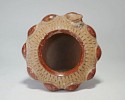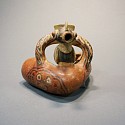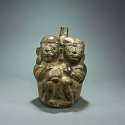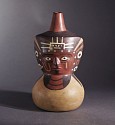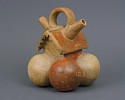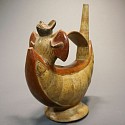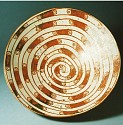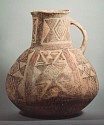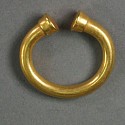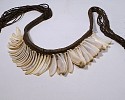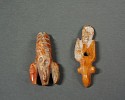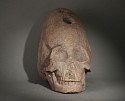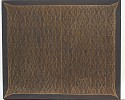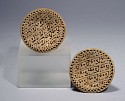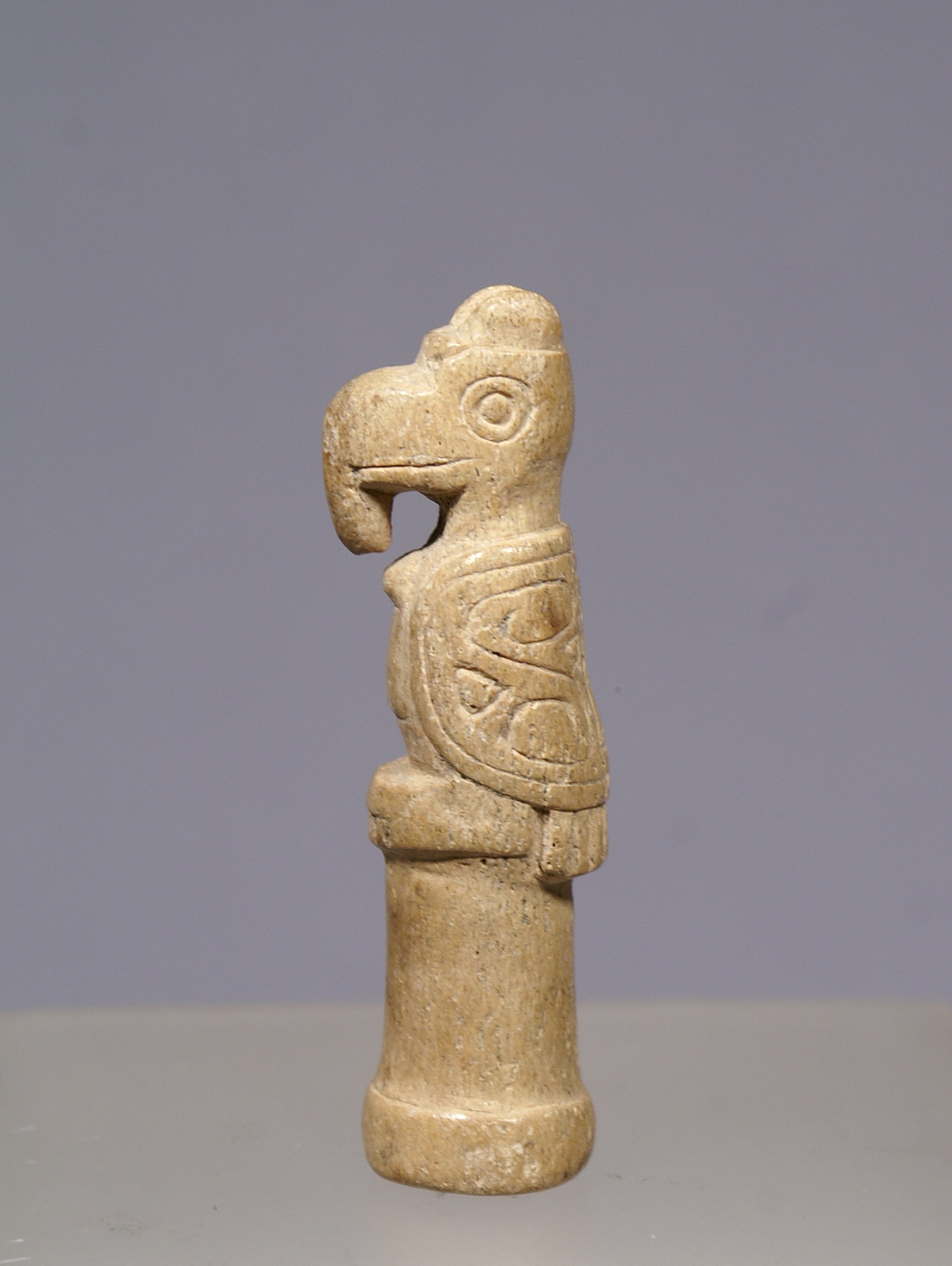
Colombia, Tairona Carved Bone Finial of a Harpy Eagle
A superbly carved finial of a male Harpy eagle standing with wings to its side. A feline face is carved in the back of the wings. Finials were placed atop staffs to display rank. Bone objects are discussed by J. Alden Mason in "Marshall Field Archaeological Expedition to Colombia 1922-23.â€
Period: Tairona, Santa Marta Colombia circa 1000-1400A.D.
Media: Bone
Dimensions: Height 2 1/2"
$2,450
95082
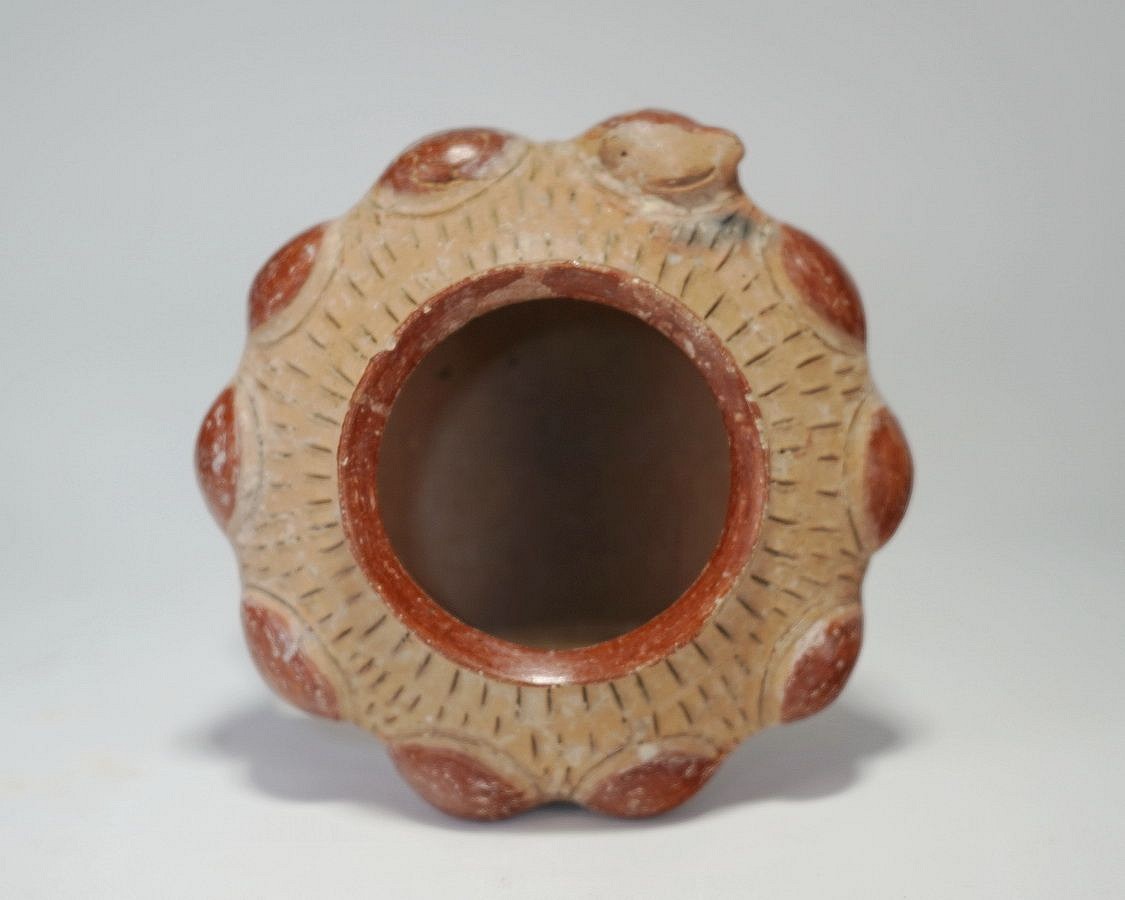





Ecuador, Classic Chorrera Miniature Bowl
This vessel is decorated with a circular ring of heads. This style of vessel is known as a meeting themed vessel. One head faces forward and the others appear to be in trance.
Media: Ceramic
Dimensions: Height: 2.5" x Diameter: 4.5"
$1,500
m6106
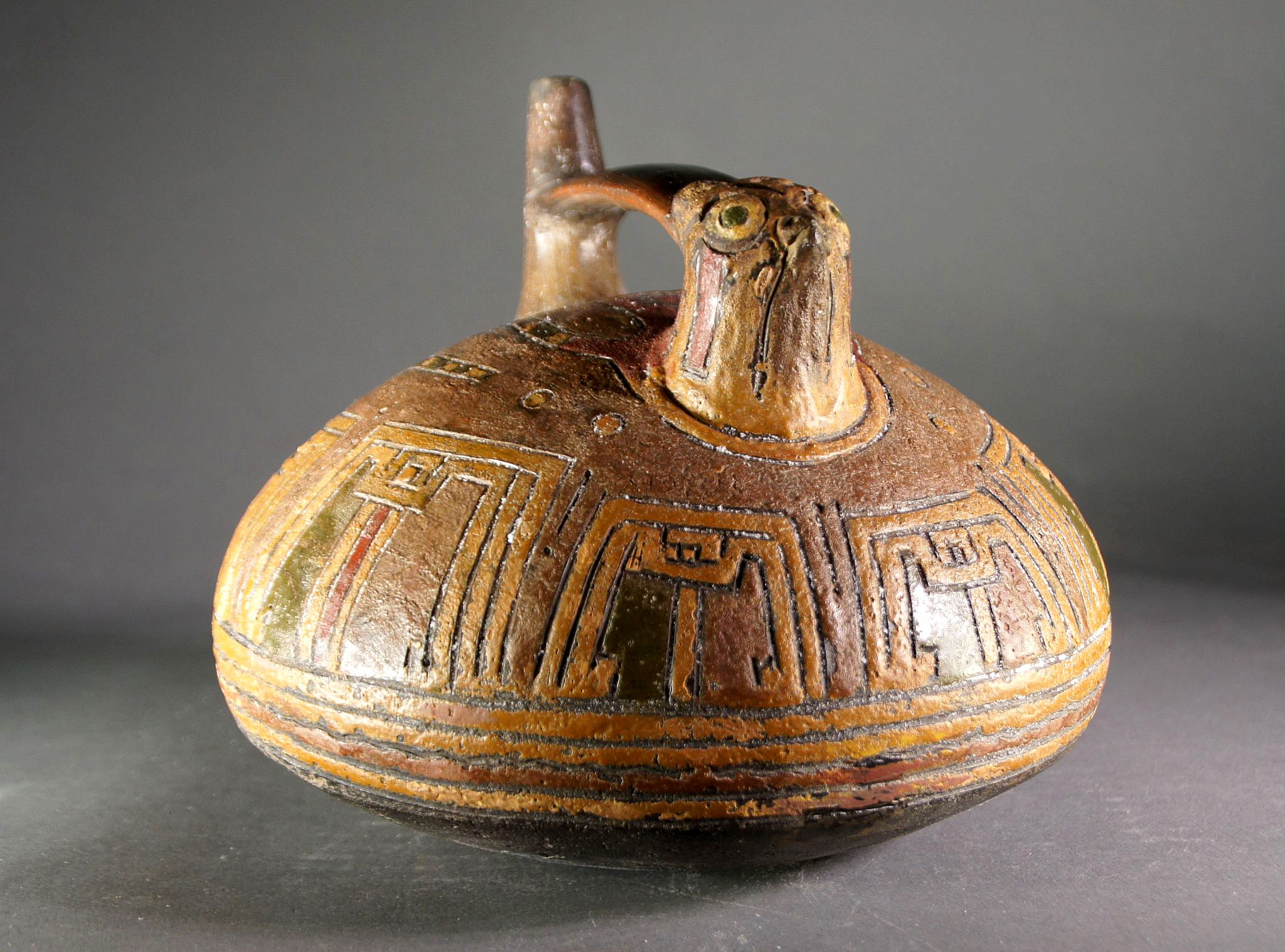







Peru, Paracas Bridge Spout Vessel with Falcon's Head
Peru, Paracas, Upper Callango basin phase 8, South Coast, c. 700 - 200 BC
This beautiful ceramic blind bridge spout vessel is crafted in the shape of a falcon with a sculpted head and incised drawings to create the falcon’s body and wings. The chamber was enhanced with a series of squarish "U" shapes, accented with a single Chavinoid eye in profile. The vessel is decorated with post-firing slip colors of red, green, brown, and tan. A similar vessel is illustrated ANCIENT PERUVIAN CERAMICS: THE NATHAN CUMMINGS COLLECTION, pages 116 & 117. A detailed discussion regarding these vessels can be found in THE PARACAS POTTERY OF ICA - A STUDY IN STYLE AND TIME on page 333.
Period: Peru, Paracas, Upper Callango basin phase 8, South Coast, c. 700 - 200 BC
Period: Peru, Paracas, Upper Callango basin phase 8, South Coast, c. 700 - 200 BC
Media: Ceramic
Dimensions: Height: 5 in. Diameter: 6 in.
Price Upon Request
n2044C
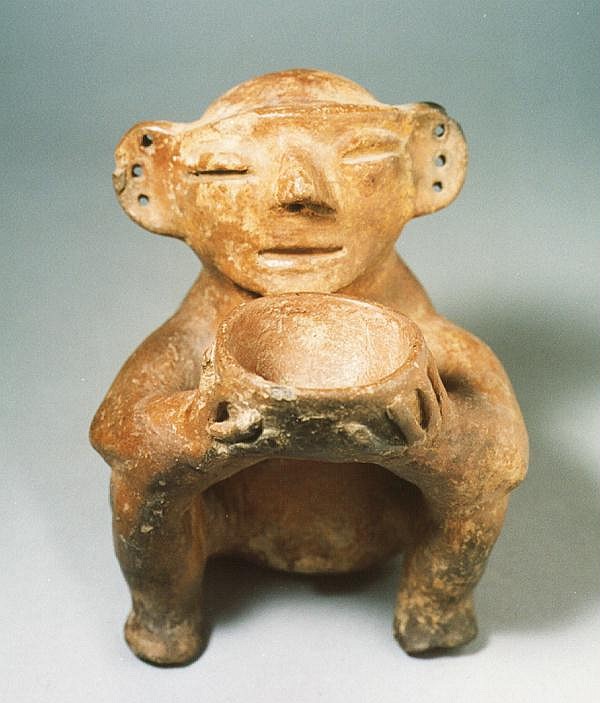
Ecuador, Ecuadorian Ceramic Seated Figure Holding a Bowl
This beautifully serene, meditative figure, perhaps a shaman, is seated in a restive position and offering a bowl. This bowl was perhaps used to inhale tobacco smoke or for drinking a ritual alcoholic or psychedelic libation. The historical record of the ancient Andes indicates shamanic use of mind-altering substances for religious rituals. A similar example is illustrated in
Meggers Evan’s Archeological Investigations on The Rio Napo.
Period: Ecuador, c. 1500 BC - AD 1500
Media: Ceramic
Price Upon Request
88203
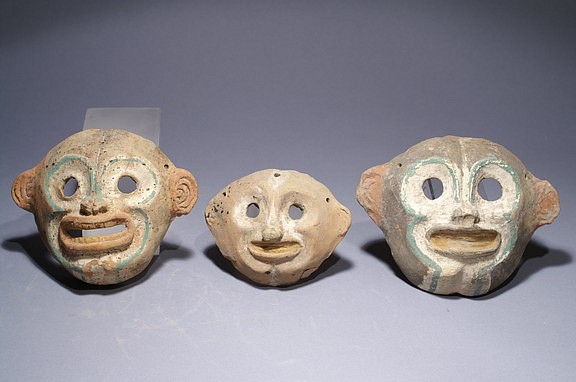
Ecuador, Pair of Jamacoaque Monkey Maskettes
These small monkey masks were decorated with post-fire pigments in blue, green, and white over a gray slip, and were probably headdress adornments for a larger ceramic effigy figure. The artisan clearly intended these masks to depict howler spider monkeys (Ateles paniscus), the largest primates in the New World. These monkeys prefer the branches of the upper forest canopy, where they feast on ripe fruit supplemented by leaves and insects. In the Amazonian mythology monkeys are associated with creator deities and cultural heroes who bestowed gifts of abundance. Monkeys were understood by ancient Andeans to be older spirits reincarnated from a mythical period prior to the presence of human beings on earth. For further reading on the legends of tropical peoples see Klein and Cevallos’ "Ecuador: The Secret Art of Pre-Columbian Ecuador," 2007, page 25.
Period: Ecuador, Jama Coaque, Northern Manabi Region, 500 BC - AD 500
Media: Ceramic
Dimensions: Height: 3" to 4"
Price Upon Request
M7102AB
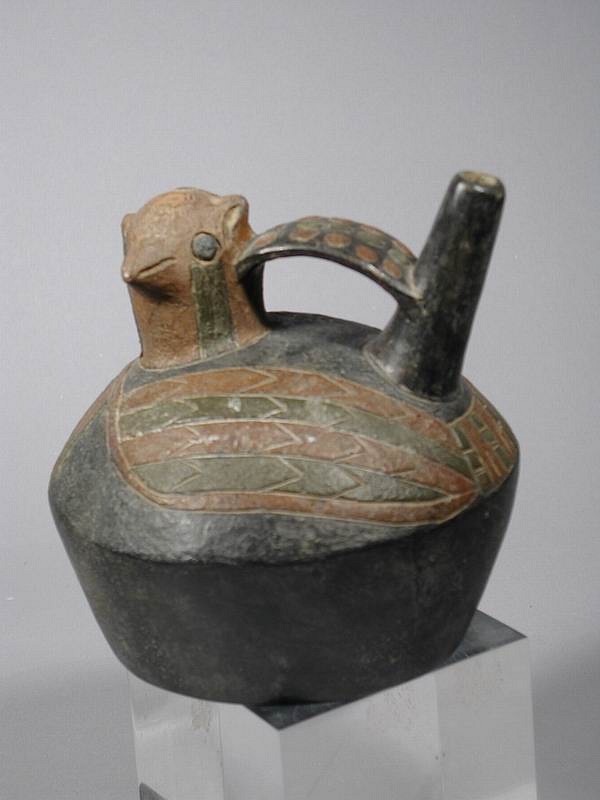





Peru, Paracas Falcon Effigy Vessel
This Paracas vessel has a blind-spout in the form of a falcon with pointed ears. The compressed, ovoid-shaped body was decorated with resin, painted, and incised, directly below the bridge spout handle. The chamber was enhanced with a series of squarish "U" shapes, accented with a central red stripe flanked by blocks of dark olive green and yellow ochre. These geometric configurations could be interpreted as highly abstracted bird forms and their presence is consistent within the development of the Phase 8 ceramic style. The use of resin painted designs outlined by incisions, referred to as "zoned" design, can also be assigned to Phase 8. Excellent literature and illustrations of the various phases of Paracas style ceramics are provided in Menzel, Rowe and Dawson's "The Paracas Pottery of Ica: A Study in Style and Time," 1969. Acquired by David Bernstein in 1994.
Period: Peru, Callango style, Paracas, South Coast, c. 700 - 500 BC
Period: Peru, Callango style, Paracas, South Coast, c. 700 - 500 BC
Media: Ceramic
Dimensions: Height 4 5/8"
$2,800
94131
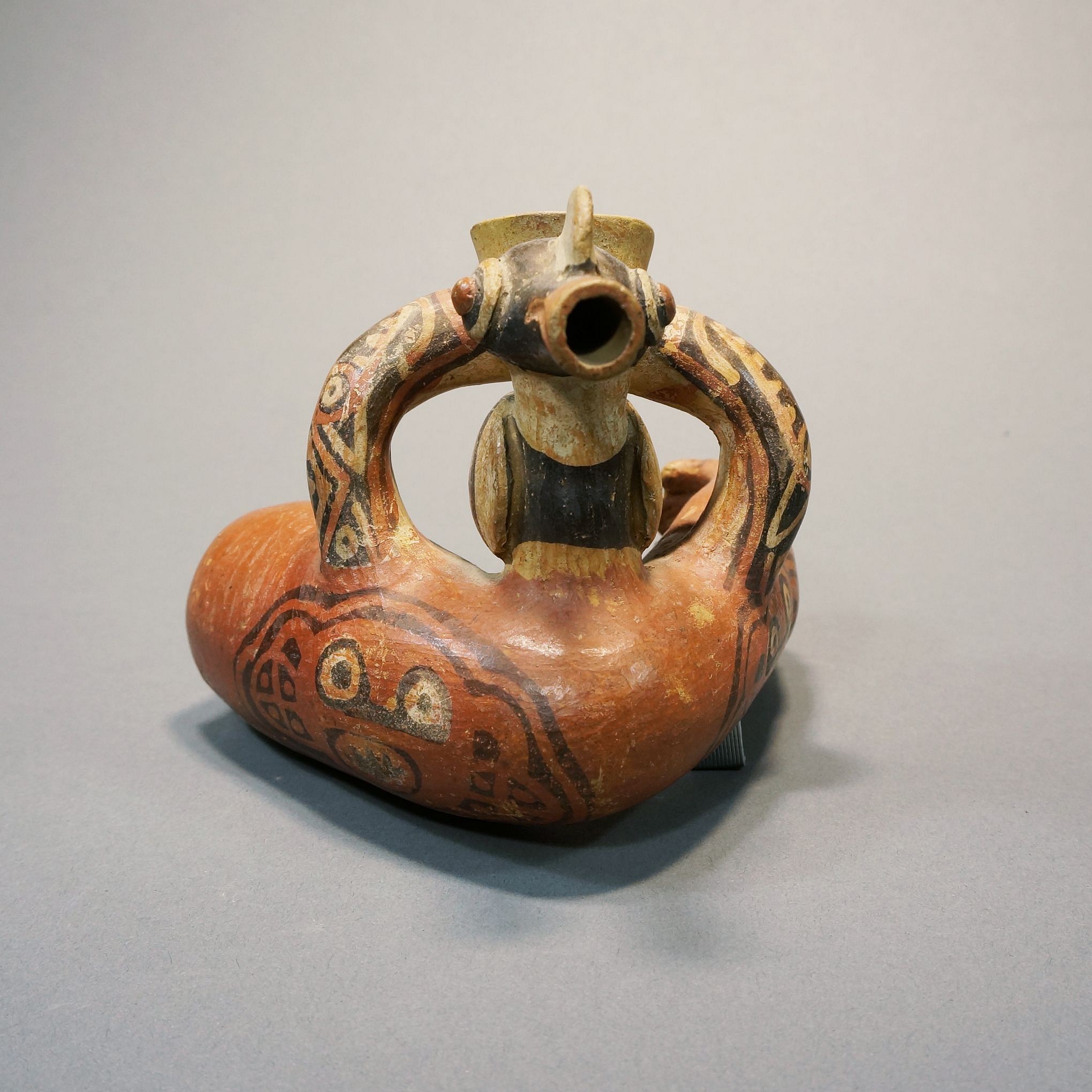
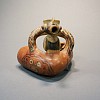
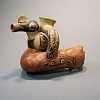
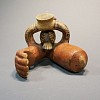
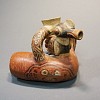
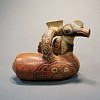
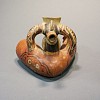


Peru, Recuay Bridge Spout Effigy Vessel
This unusual figurative effigy depicts a clenched human arm decorated with a tattoo of a face with ear spools and a large-eye condor siting under the bridge spout.  The painted face is referred to as the "circular head motif" and signifies a celestial deity (Grieder, Terrence, The Art and Archaeology of Pashash, 1978). The condor is the largest and most powerful bird in the Andes. The clenched fist motif depicts a severed bone, the meaning of which is not clear, however, condors were known to eat the remains of sacrificed captives.  A similar example is in the Berlin Volkeunde museum and is illustrated in KULTUREN RECUAY IV by Deiter Eisleb, pg.194.
Period: Peru, Recuay, North Highlands, c. 300 BC - AD 700
Media: Ceramic
Dimensions: Height 4 1/8"
$3,500
96148
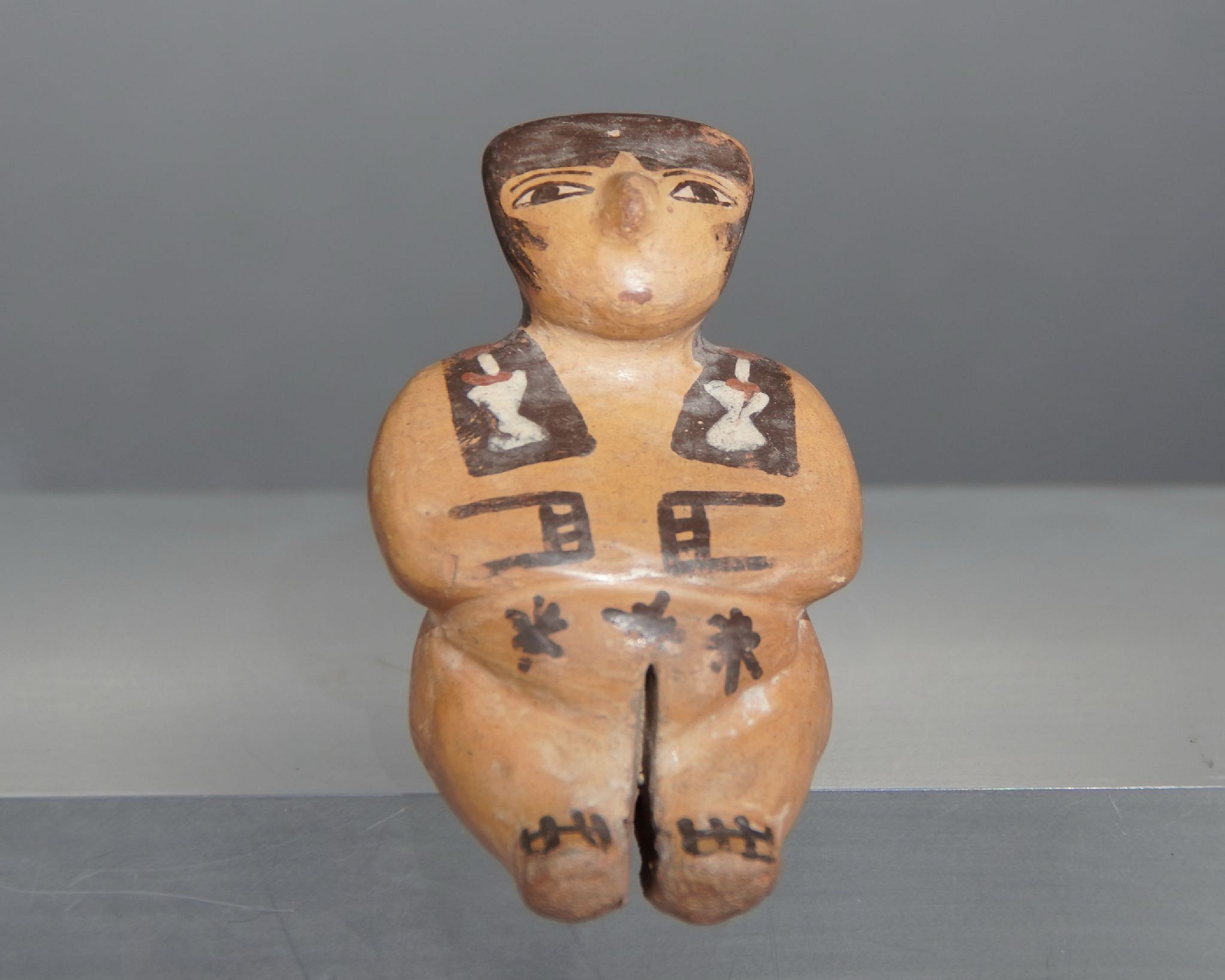





Peru, Nasca Miniature Female Seated Figurine
This seated ceramic female has hands painted on her belly, black hair painted falling over the shoulders, white hair ornaments, and tattoos painted on each buttock. The intricate tattoos depict the San Pedro cactus, which is known to have psychoactive properties. The archaeological record indicates that San Pedro cactus was likely used by the ancient Andeans as a libation during shamanic ceremonies. This figurine would originally have been dressed in a miniature woven garment, which was eroded or lost over time. A similar figure is illustrated in A Sourcebook of Nasca Ceramic Iconography, p. 146. Ex. collection Jean Lions, France.
Period: Peru, Nasca, South Coast, c. AD 400 - 800
Media: Ceramic
Dimensions: Length: 7.1cm
$1,800
M4049
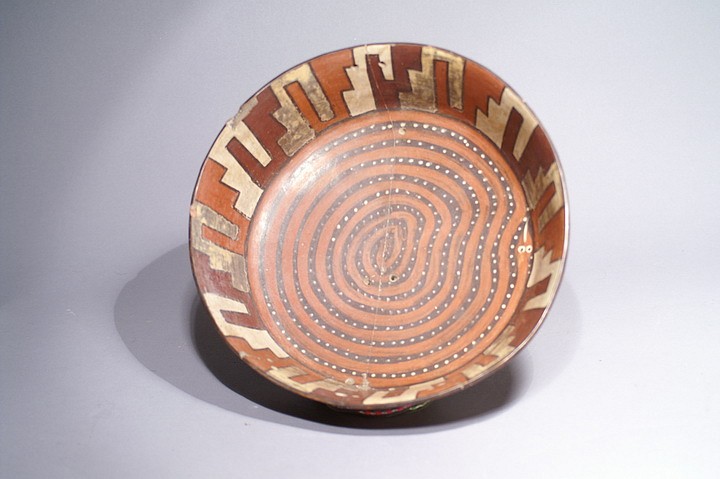
Peru, Nazca Polychrome Dish with Serpent Motif
This wonderful Nazca ceramic dish is painted with a spiral serpent motif at the bottom. The serpent is painted with a pattern of white dots. The inner edge of the dish’s high wall is painted with a step-fret pattern in alternating in colors of maroon, white and orange. The step-fret motif likely represents stairs to a temple or stepped agricultural plains, both of which were important to the Nazca. On the outside rim of the dish are 10 painted zoomorphic faces with long noses. The bottom of the dish is painted black. There is evidence of ancient repairs made to the dish, which can be seen via small drill holes made on each side of a crack and binding applied to the crack. Benno Mattel collection, Punta del Este, Uruguay.
Period: Peru, Nasca, Proto Phase, South Coast, c. 100 BC - AD 200
Media: Ceramic
Dimensions: Diameter 9 1/2" x height 2 1/2"
Price Upon Request
N1032
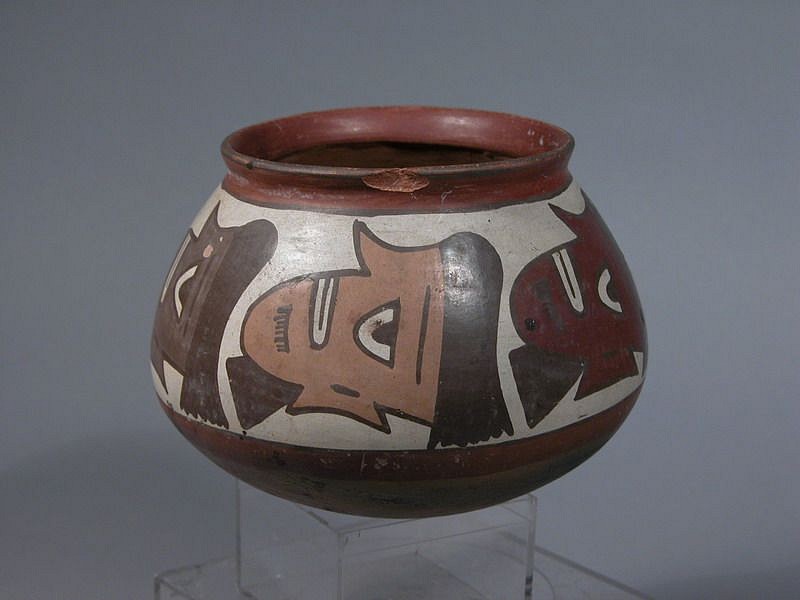




Peru, Small Nasca Bowl with Painted Trophy Heads
The trophy heads are in profile and alternating in red, grey and beige on a cream ground. Trophy head paintings by the same artist are in the Volkunde Museum in Berlin and are illustrated in ALTPERUANINISCHE KULTUREN –NAZCA II, in figures 120 & 121. Ex. collection Hans Monheim, Achen Germany.
Period: Peru, Nasca, South Coast, c. AD 400 - 800
Media: Ceramic
Dimensions: Height 3 3/4" x Diameter 3 3/8cm
Price Upon Request
M4035
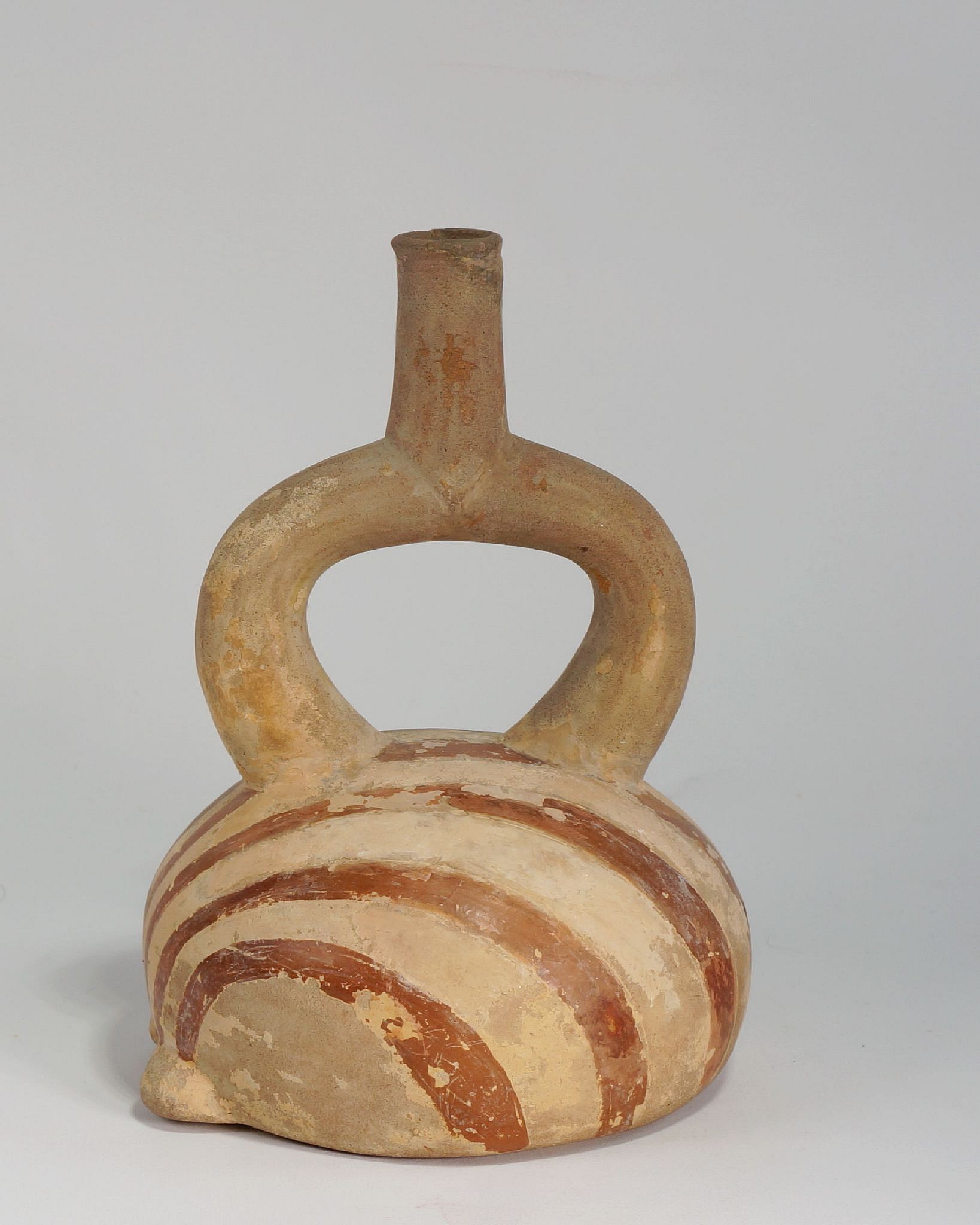




Peru, Stirrup Spout Vessel Depicting a Scallop
This elegant vessel is modeled after the Argopectin purpuratus (the Peruvian calico scallop). It is decorated with swirling painted stripes in brown slip on a cream ground and is a typical example of Moche realism. During El Niño events, bivalves proliferate along the coast; scallops are the most abundant species. The bivalves, in turn, attract octopi, which feed almost exclusively on these mollusks. Octopi are a frequent theme in Moche art. A similar example of a stirrup spout vessel in the form of a bivalve shell is illustrated in The Spirit of Ancient Peru: Treasures from the Museo Arqueologico Rafael Larco Herrera, edited by Kathleen Berrin (1997: fig. 41).
Period: Peru, Moche II, North Coast, c. AD 200 - 350
Media: Ceramic
Dimensions: Height 7"
Price Upon Request
95065
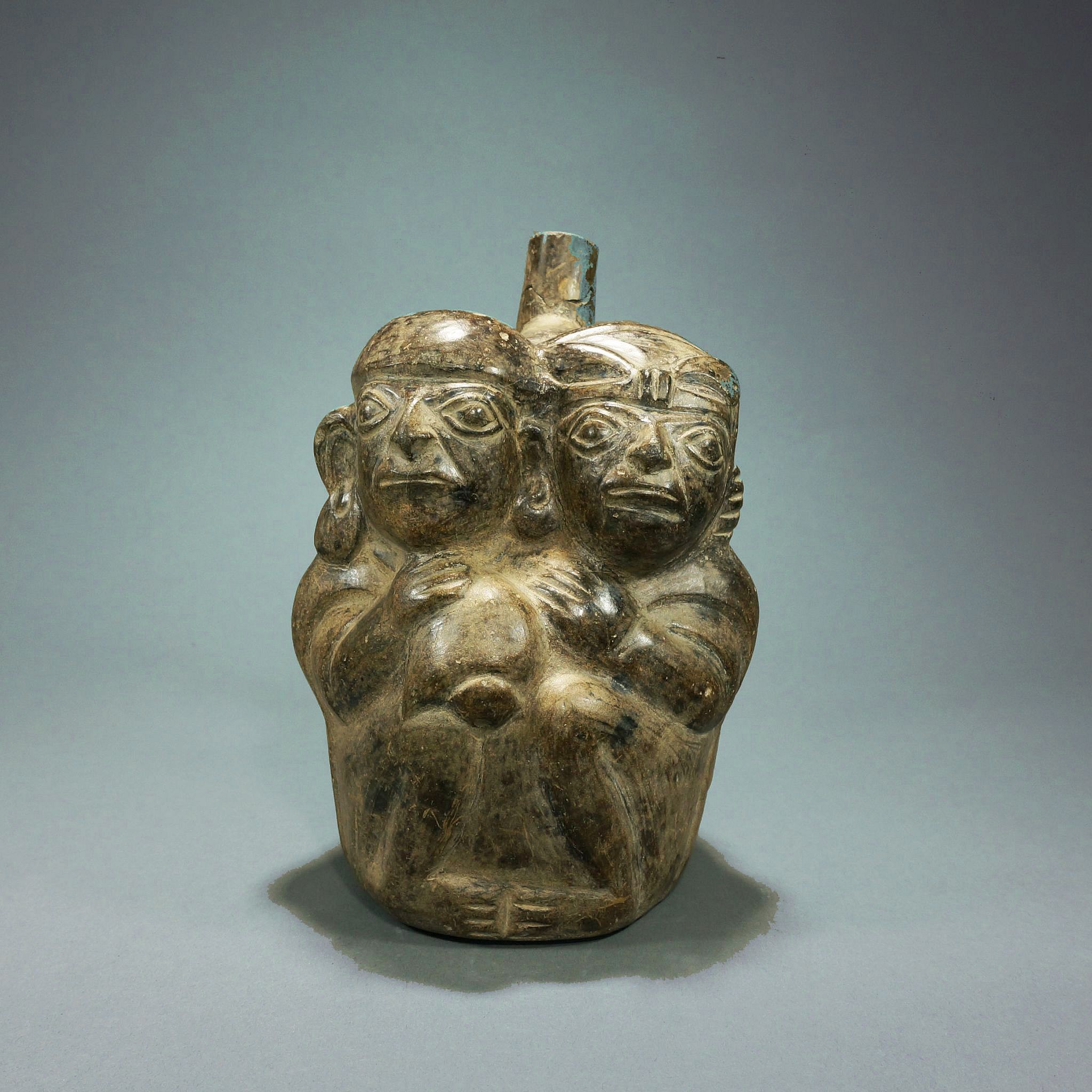
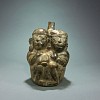
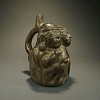


Peru, Moche II Grayware Vessel with Embracing Couple
An embracing couple is an extremely rare subject for Andean art from any culture. Although ancient Andean art features many human characters such as hunters and shamans, as well as semi-human deities with a wide range themes and emotions, romantic couples are not a common theme. In this sculptural depiction of a Moche couple, the male wears large ear ornaments, and holds a conch trumpet, and the female wears a feather plume in her hair, all signs of wealth and status.
Period: Peru, Moche II, North Coast, c. AD 200 - 350
Media: Ceramic
Dimensions: Height 8"
Price Upon Request
M9015H
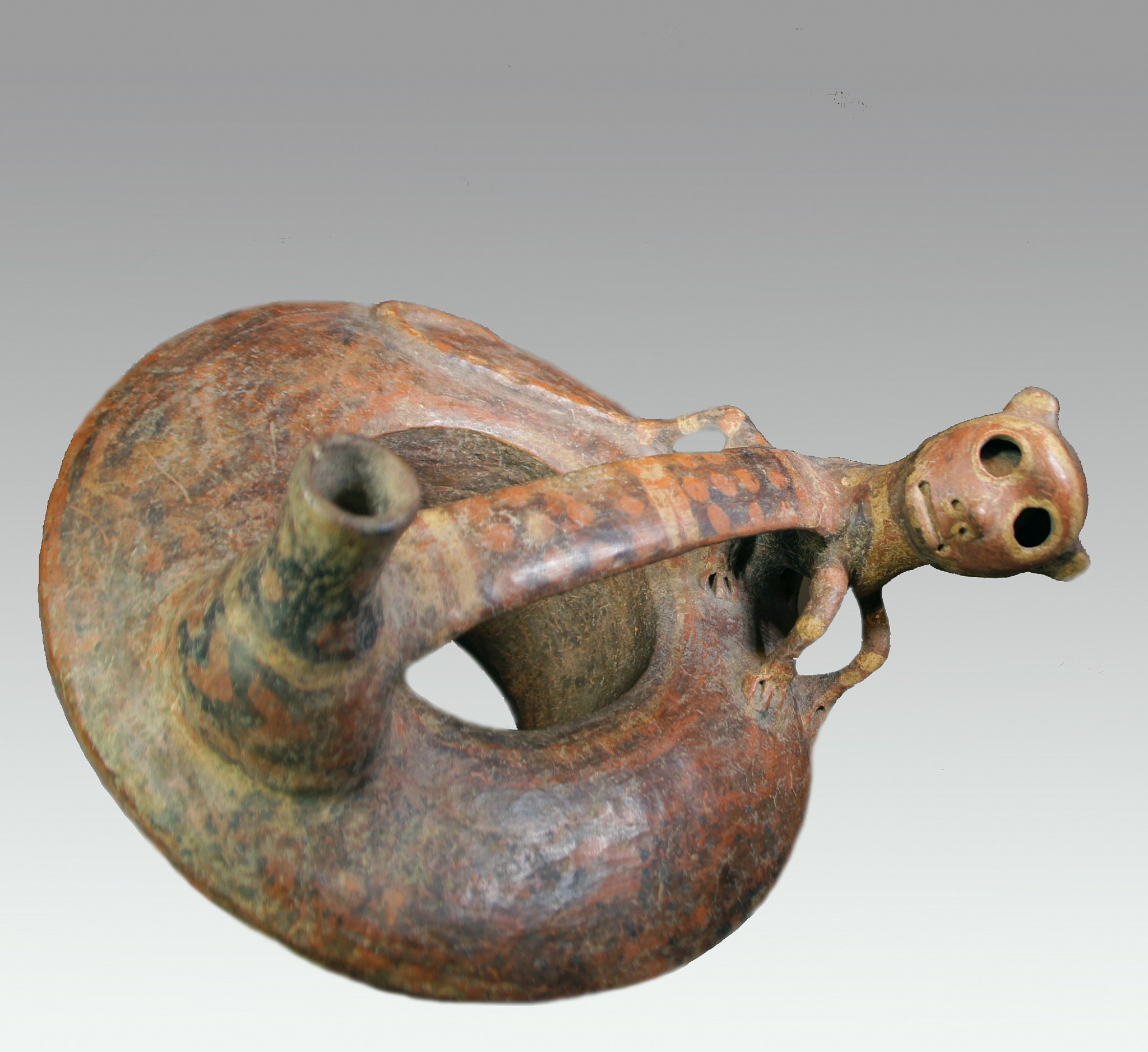





Peru, Vicús Donut-shaped Whistle Vessel with Monkey
This donut-shaped whistle vessel has a monkey figure one side of its bridge spout and the mouthpiece at the other end. The monkey sits on top of the vessel, with its head slightly tilted, hunched on its hind legs and placing his front legs forward and spread apart. The design motif consists of negative resist decoration. There is a whistle inside the monkey (not working) and would operate when the fluid inside the vessel moved the air out through it. A similar example can be found in Lapiner's "Pre Colombian Art of South America" pls.456 & 459. The piece has a crack on the bottom, which has been restored.
Period: Peru, Vicus, Far North Coast, c. AD 200 - 400
Media: Ceramic
Dimensions: Diameter 8 1/2 x h.7 in.
$3,300
92233
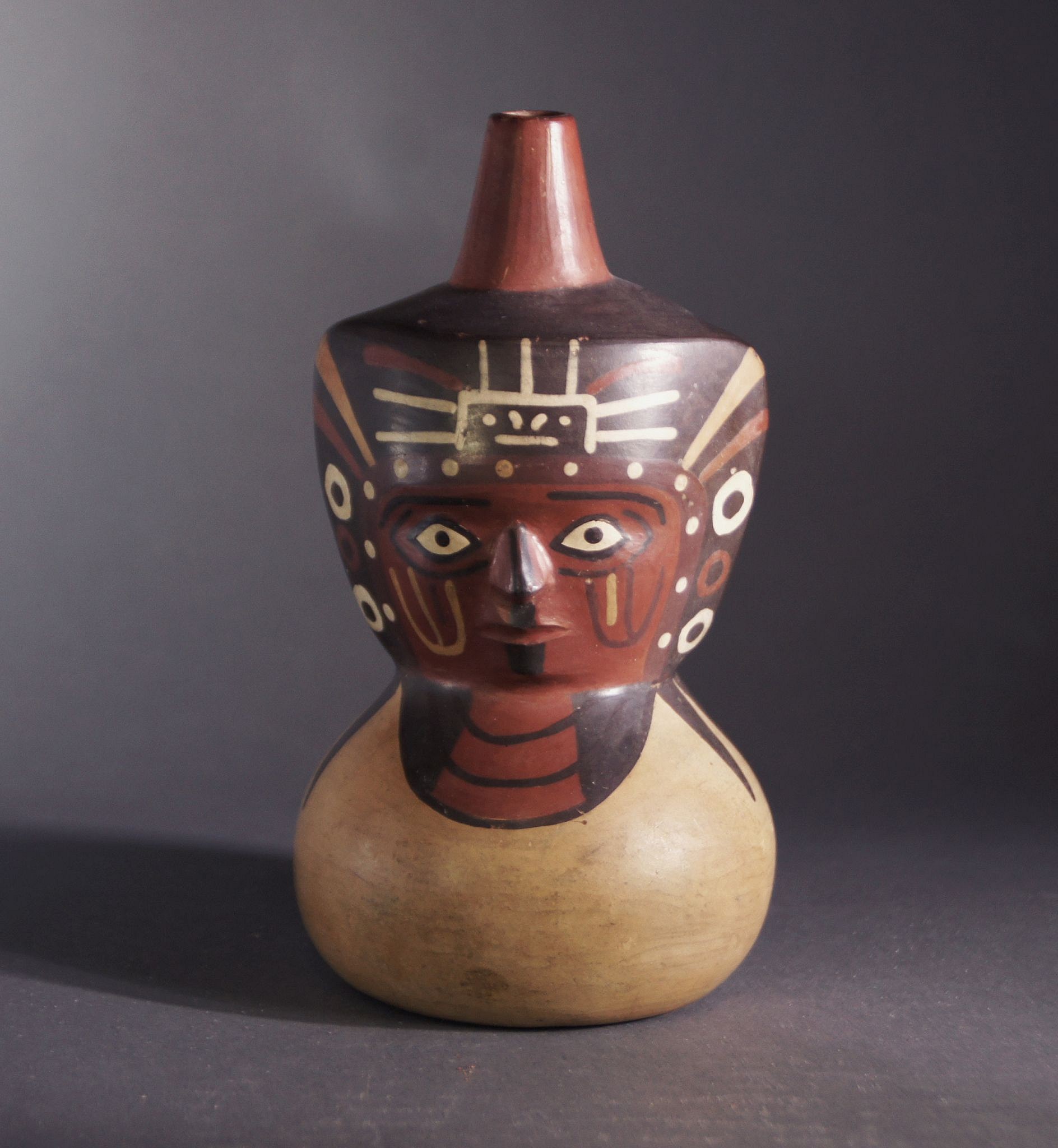


Peru, Wari Single Spout Figural Bottle with Elaborate Facial Decoration
This effigy vessel is painted with an individual wearing a diadem on his headdress and as well as a triple-strand necklace, indicating that he is a shaman or other important personage. He wears a black head covering, which is depicted draped around the shoulders. Ex. collection Anton Roeckl, Munich. T/L tested in Berlin.
Period: Peru, Wari, South Coast, c. AD 600 - 900
Media: Ceramic
Dimensions: 6 in.
Price Upon Request
94114A
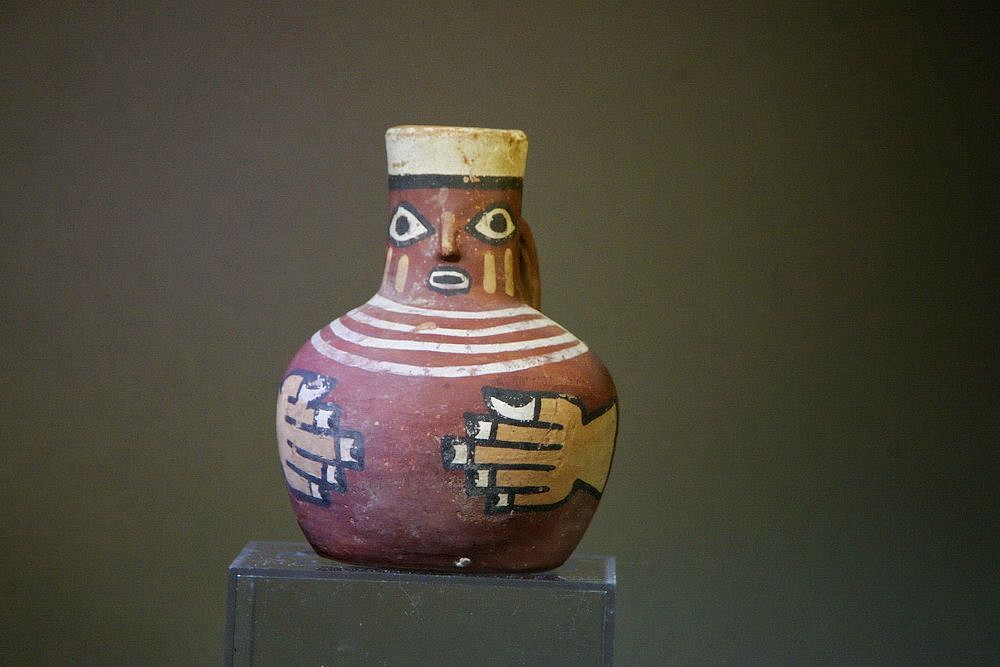





Peru, Wari Miniature Effigy of a Man with Large Hands
This is a common style of figurative vessel painted by the Wari and most likely represents a feasting man with a full belly. The Wari held large communal feasts where food was served along with chicha, corn beer, which was spiked with psychoactive plants such as Peruvian pepper – as found at Wari archaeological sites. This vessel is one of a set that was found at the same gravesite.
Period: Peru, Wari, South Coast, c. AD 650 - 900
Media: Ceramic
Dimensions: Height 4 3/4"
Price Upon Request
n3024
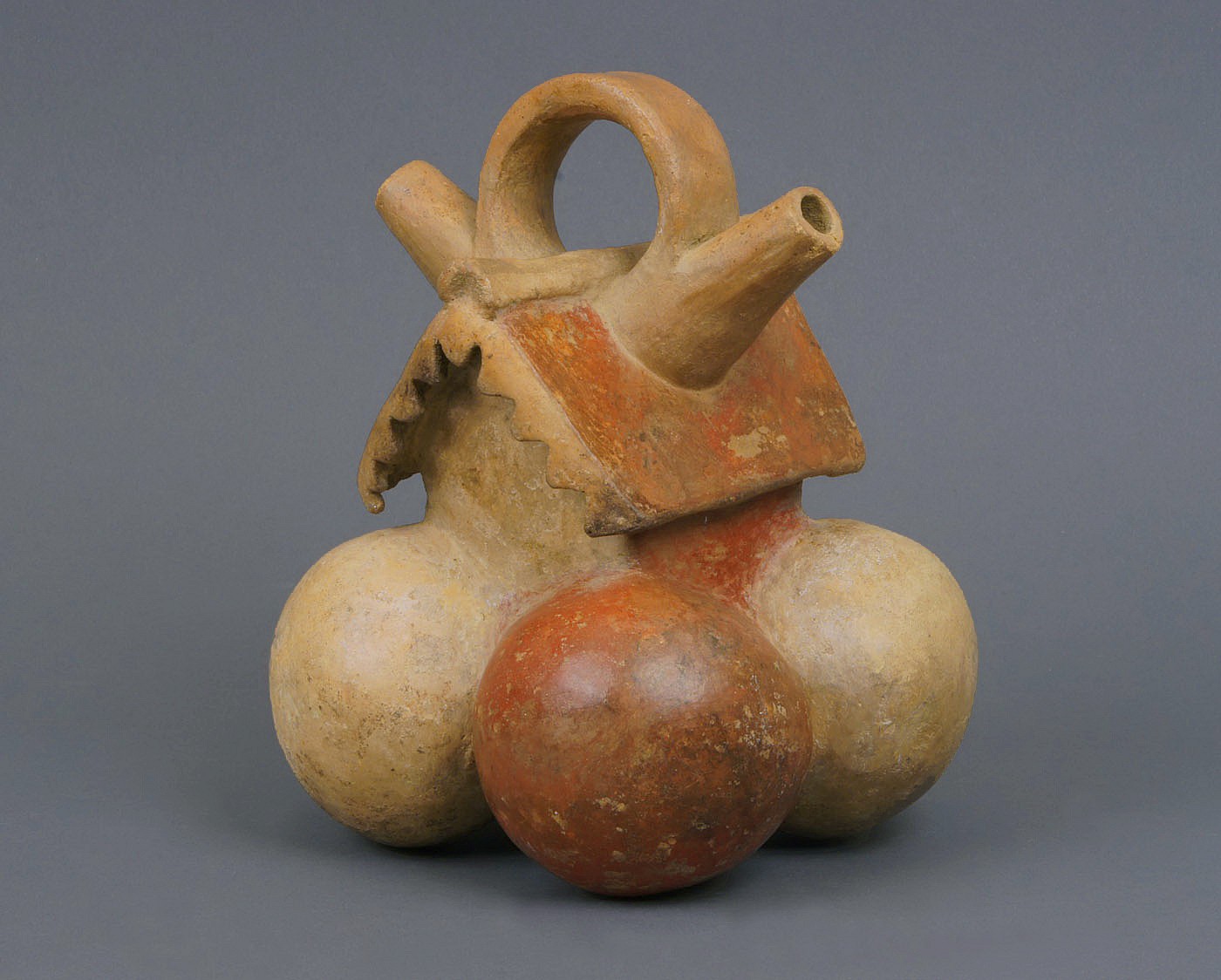


Colombia, Calima Effigy Vessel in the Form of a House
A house model resting on four globular feet. Vessels from the Calima region of Colombia, also known as alcarazzas, have a very distinct shape, typically with two spouts on the diagonal. For more examples, see "Colombia Before Columbus" by Armand Labbe (1986: 64-95) and "Calima" by de Schrimpff, Bray et. al. (1992: 113-118), which is where the reference drawing shown here has been taken from. A number of alcarazzas represent houses and probably mimic the actual dwellings of ancient societies in Calima.
Period: Colombia, Calima, Yotoco Phase, Cauca River Valley, circa AD100-1000
Media: Ceramic
Dimensions: Height 8"
$3,500
99318
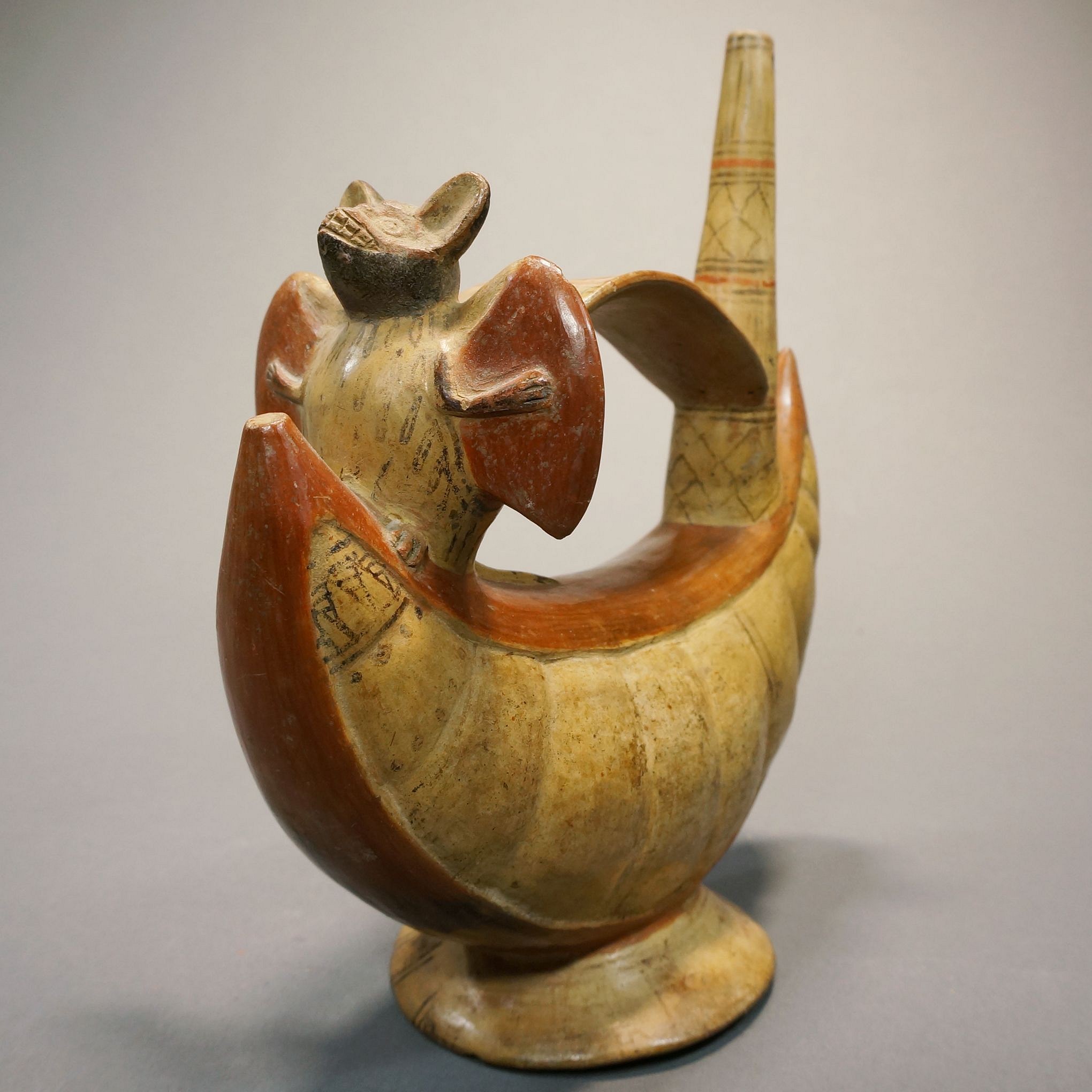
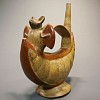
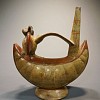
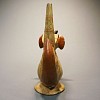
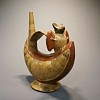
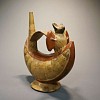
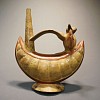
Peru, Lambayeque Whistling Vessel with Bat Atop Pacay Fruit
This ceramic bridge-spout whistling effigy vessel was crafted in the shape of fruit bat resting atop a Pacay. The Pacay fruit, found in the Amazon, is related to mangoes and guavas. Fruit bats have an extremely good sense of smell and sharp teeth with which to open the tough skins of fruits. The whistle built into the vessel, customary for Lambayeque vessels, is seen just behind the bat. Bats are a rare motif and quite meaningful in ancient Andean mythology as they are associated with transport to other worlds. The vessel was painted with orange slip and black octopus ink on a buff ceramic ground. There are only two other known Lambayeque vessels with sculptures of bats, one is illustrated in "Ceramics of Ancient Peru" by Christopher Donnan, 1992, p.89, and the other is the property of The American Museum of Natural History.
Period: Peru, Sican, c. AD 800 - 1100
Media: Ceramic
Dimensions: Height 8" x Length 6 1/2"
Price Upon Request
mm145
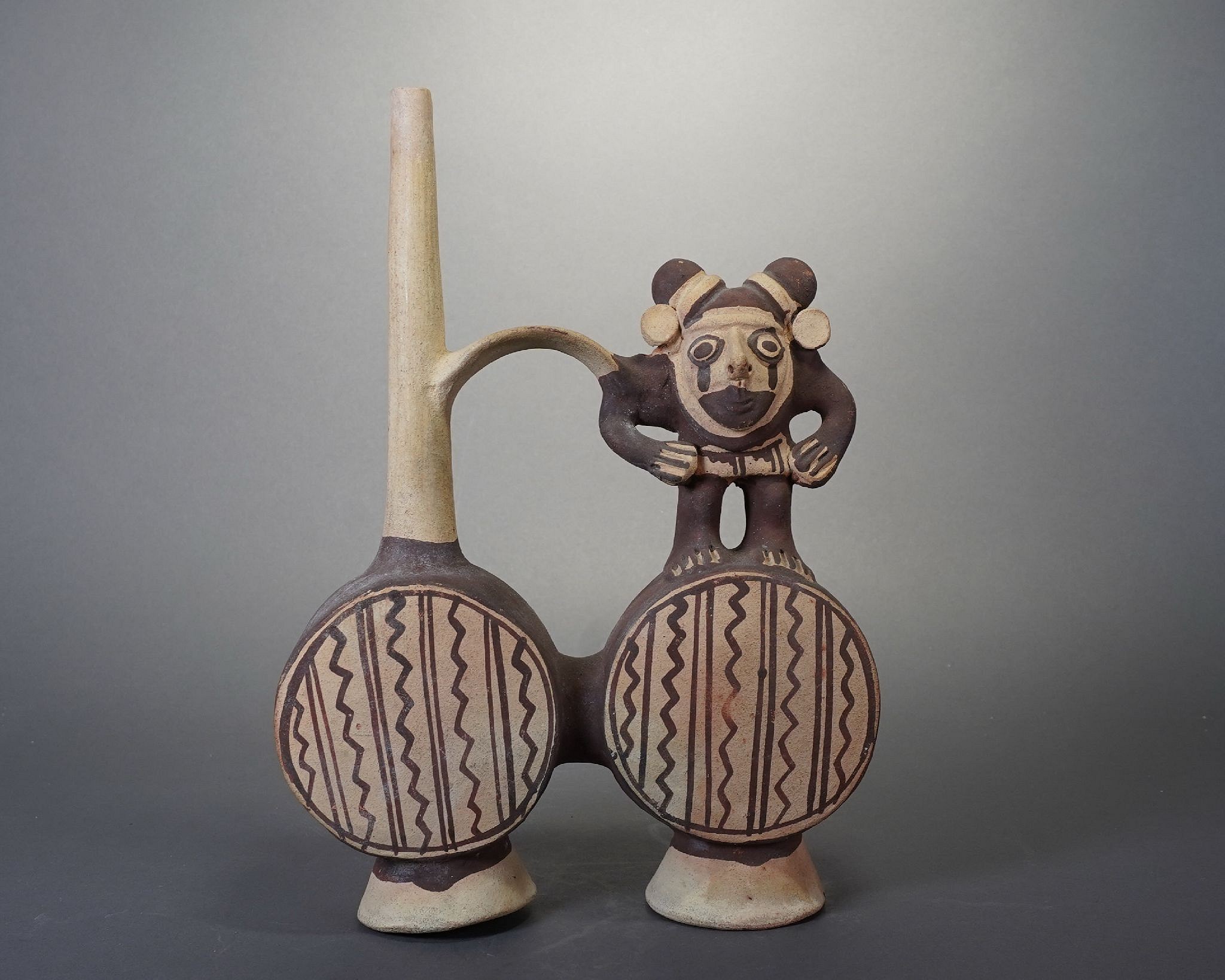



Peru, Chancay Double-Chambered Whistling Vessel with Animal Impersonator
The Chancay people were known for their ceramic workshops, where series of similar items were produced in groups. This bridge-spout vessel has two chambers and is painted with alternating straight and wavy lines. The figure sitting atop the vessel is an Animal Impersonator of a monkey. “Animal Impersonator†is a term used by Pre-Colombian scholars to refer to a shaman who dresses as a certain animal to embody the mythological characteristics associated with that animal. Monkeys, who dwell at the top of the forest canopy in the Amazon, are associated with ancestral secrets in Andean mythology. This shaman has a hairstyle arranged in two coils to resemble monkey ears, as well as white ear spools. He is hunched over and holds a weaving in his arms.
This vessel may have been used to pour a psychoactive brew as part of a shamanic rite. When brew was poured, the air moved from one chamber to the other, creating a whistling sound. The tone of the whistle was created by the specific shape of the resonance cavity. Whistling sounds would have enhanced the shamanic ritual. According to author Daniel K. Stat’s article Ancient Sounds: The Whistling Vessels of Peru, “the psycho-acoustical effects appear to be created by low frequencies or difference tones, or possibly the interaction of harmonic principles, which are produced when several vessels from a specific culture are played simultaneously.â€
This vessel would also have been intended for its owner for use in the afterlife.
Period: Peru, Chancay, Central Coast, c. 900 - 1300
Media: Ceramic
Dimensions: Height: 10 1/2" x Width: 7"
$1,400
n9047
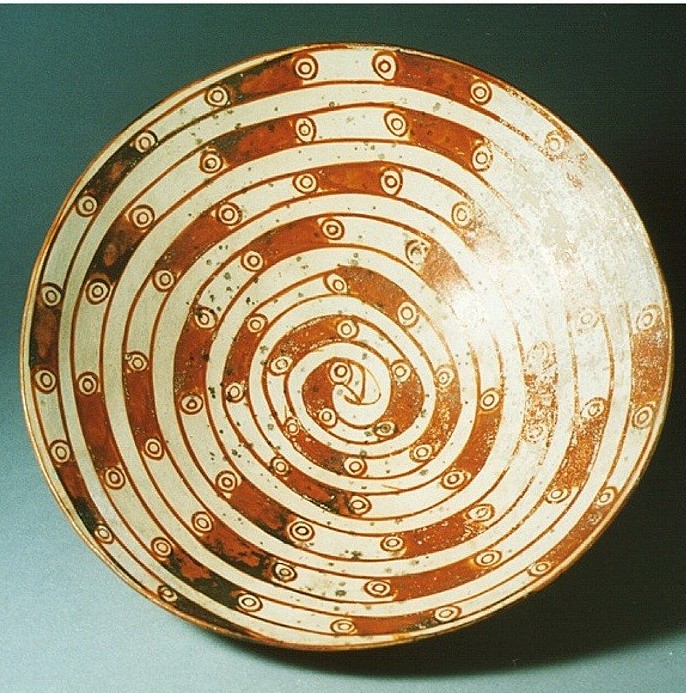
Peru, Cajamarca Low Orangeware Bowls with Coiled Serpent
This bowl has an orange and white spotted coiled serpent motif and a footed base. The Cajamarca culture has a long role in Peruvian pre-history going back to Chavin times until 1532 when the Inca king Atahualpa was killed by Pizarro. Today there still exists a beautiful cut stone "Inca Bath" of warm mineral water that was enjoyed by Inca nobility. A similar style of ancient plate from Cajamarca is in the Museum at Cajamarca. The orange and white slip decoration demonstrates the high artistic control that the Cajamarca artisans had over the medium. A great deal of control over the firing process was required to prevent the orange slip from turning brown
Period: Peru, Cajamarca, North Highlands, c. AD 1000 - 1400
Media: Ceramic
Dimensions: Diameter: 10 inches.
Price Upon Request
97111a
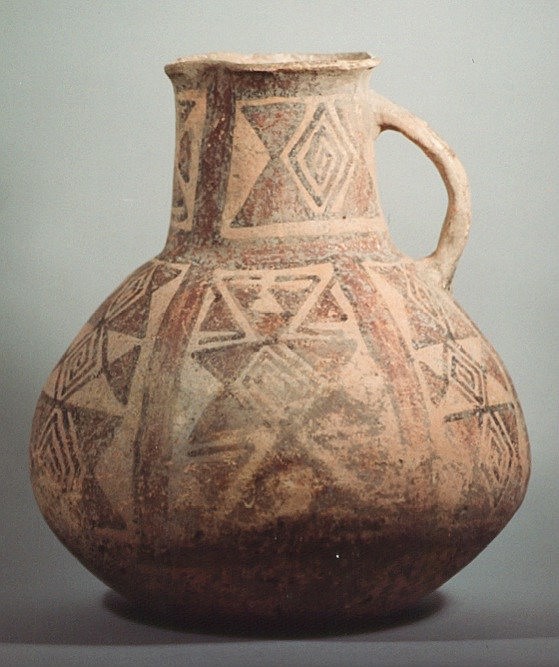
Bolivia, Bolivian Ceramic Vessel Decorated with Geometric Designs
Large ceramic jug handle vessel with geometric designs of concentric diamonds in red, brown, and black slip on a pink buff ground. Vessels with similar designs are also found in Arica, Chile and Southern Bolivia, and appear to be a regional integration style.
Period: Bolivia, Inca, c. 1440 - 1532
Media: Ceramic
Dimensions: Height 11"
94207x
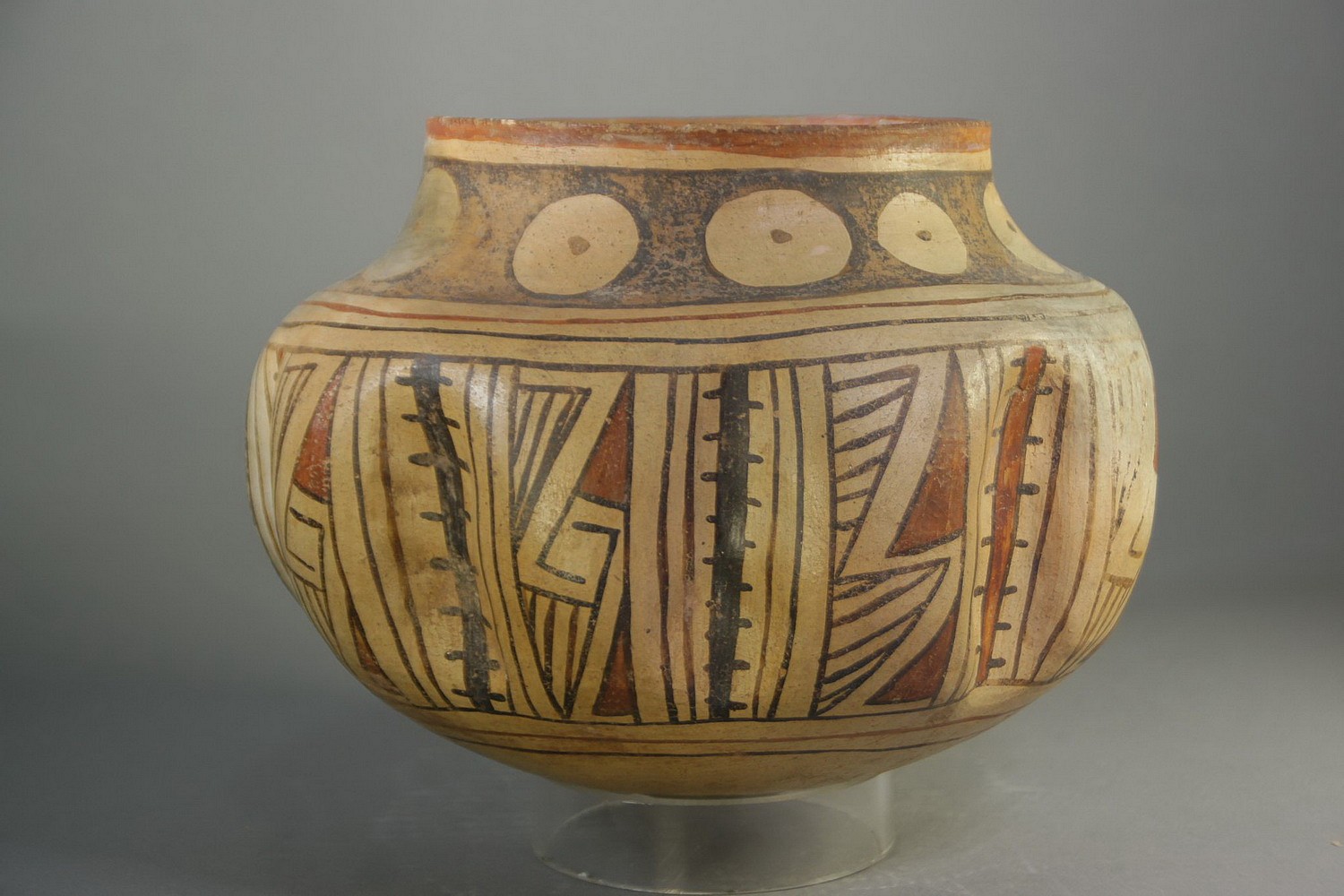




Mexico, Casas Grande Gadrooned Ceramic Vessel with Geometric Designs
This unusual ceramic bowl has nine fluted sections separated by symbolic cacti imagery. The bowl is painted with red and black geometric designs on a beige ground. On the bottom are three large concentric black lines. It has a tapered neck that is decorated with nine beige circles on a black ground. Each circle has a central black dot, which symbolizes an aerial view of a cactus. This vessel originates from Casas Grande, a site located in the Mexican state of Chihuahua, along the Casas Grande River and South of the US Puebloan ruins. A good reference is “Casas Grandes and the Ceramic Art of the Ancient Southwest†by Richard Townsend, published by the Art Institute of Chicago. The bowl is in good condition with one crack on the bottom restored and a small hole on one of the fluted sections. All parts original.
Period: Mexico, Casas Grande Classic Period c. AD 1250 - 1475
Media: Ceramic
Dimensions: H. 6" x W. 8"
$2,900
n2046
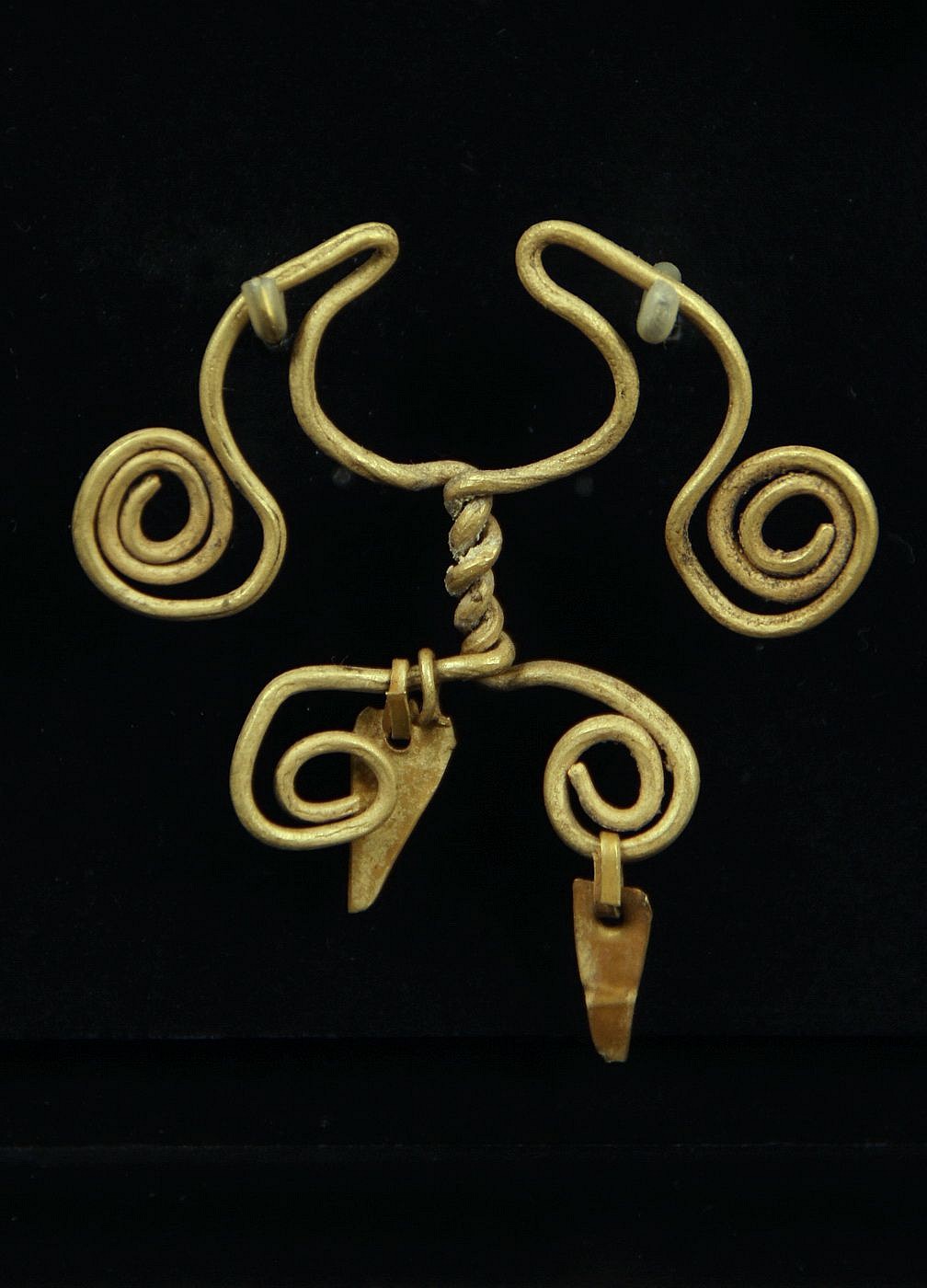
Peru, Chavin Gold Spiral Nose Ring with Two Twisted Wires and Two Dangles
This wire nose ring was made of one hammered sheet of gold, folded on itself, and cut. The ornament was hammered and coiled with the original suspended dangles.
Period: Peru, Chavin, North Coast, c. 1500 - 400 BC
Media: Metal
Dimensions: Height:1 1/4" Weight: 4.8 grams
$2,100
94222
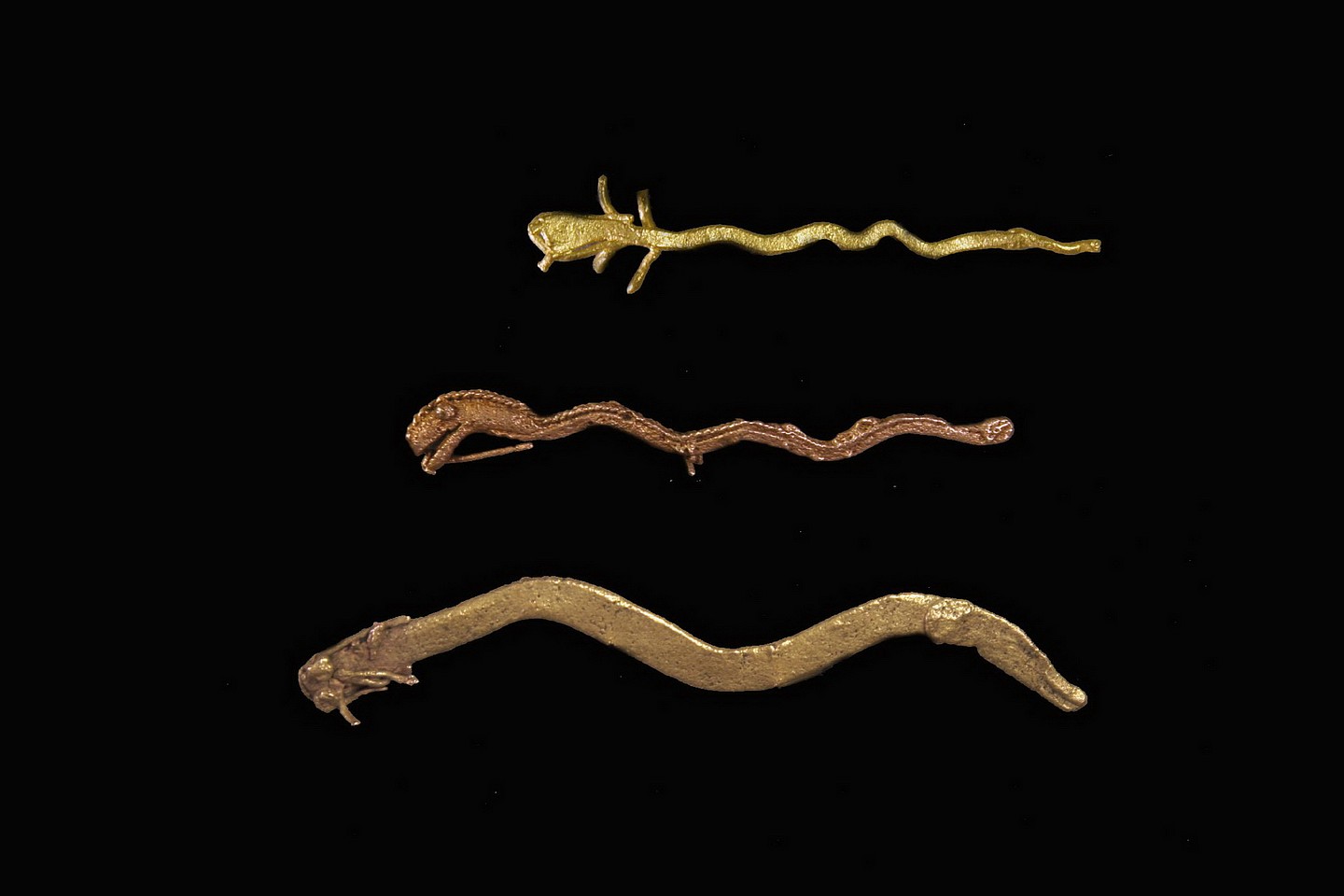


Colombia, 3 Muisca Cast Gold Snakes
The Muisca people of Eastern Columbia were known for their famous myth, El Dorado. El Dorado refers to a Lord on riding on a golden raft and covered in gold dust. Serpents are featured prominently in the Muisca creation myth, which describes two snakes emerging from the Iguaque lagoon as a women and child. Transmutation was an important theme to the Musica; these snakes are all cast using the lost wax technique as well as the manipulation of alloys to create the three different hues of gold.
Period: Colombia, Muisca, c. AD 700 - 1500
Media: Metal
Dimensions: Length: 1. 7/8, 2. 3/16 & 3. 9/16 inches; Total Weight: 5.2 grams
$2,400
n8006
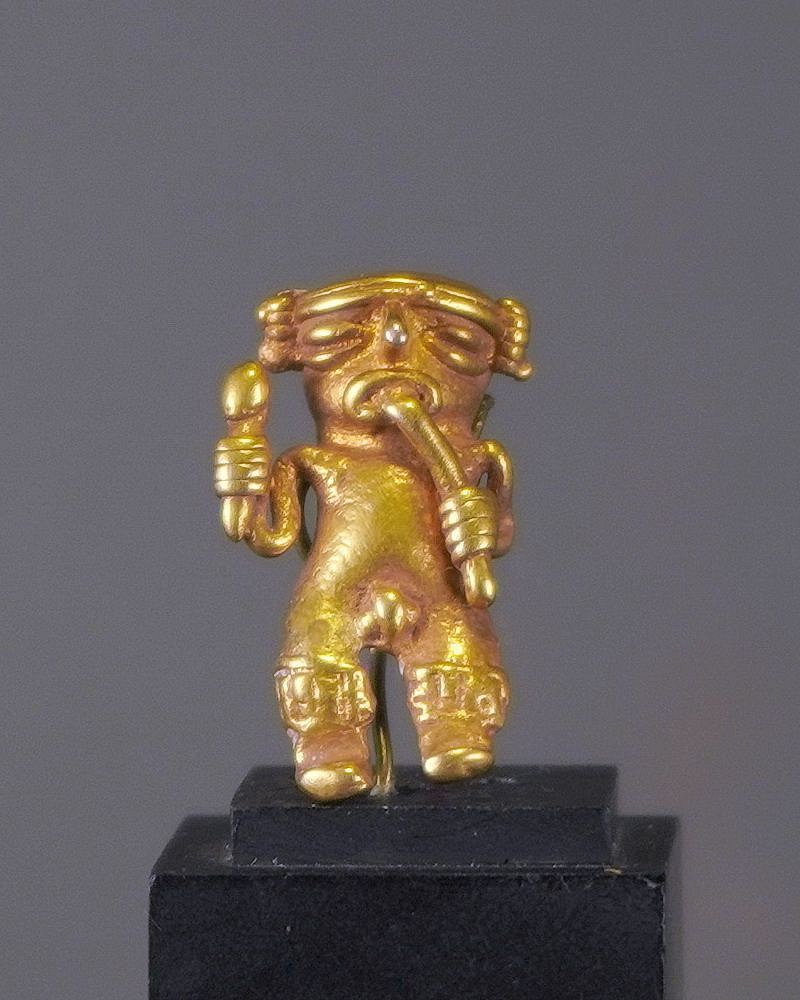




Costa Rica, Chiriqui Cast Gold Miniature Flute Player
This miniature gold shaman is seen playing a flute and holding a rattle in the left hand. Music was known to facilitate trance states and psychological healing during psychedelic shamanic rituals. A similar piece is illustrated in THE ART OF PRECOLUMBIAN GOLD - THE JAN MITCHELL COLLECTION on page 101. From the collection of Karin Ashburn by descent from her father Benno Mattel of Uruguay.
Period: Costa Rica, c. AD 1000 - 1500
Media: Metal
Dimensions: Height: 1 1/16" ( 2.7cm) Weight: 4.9grams
$1,900
n4027C
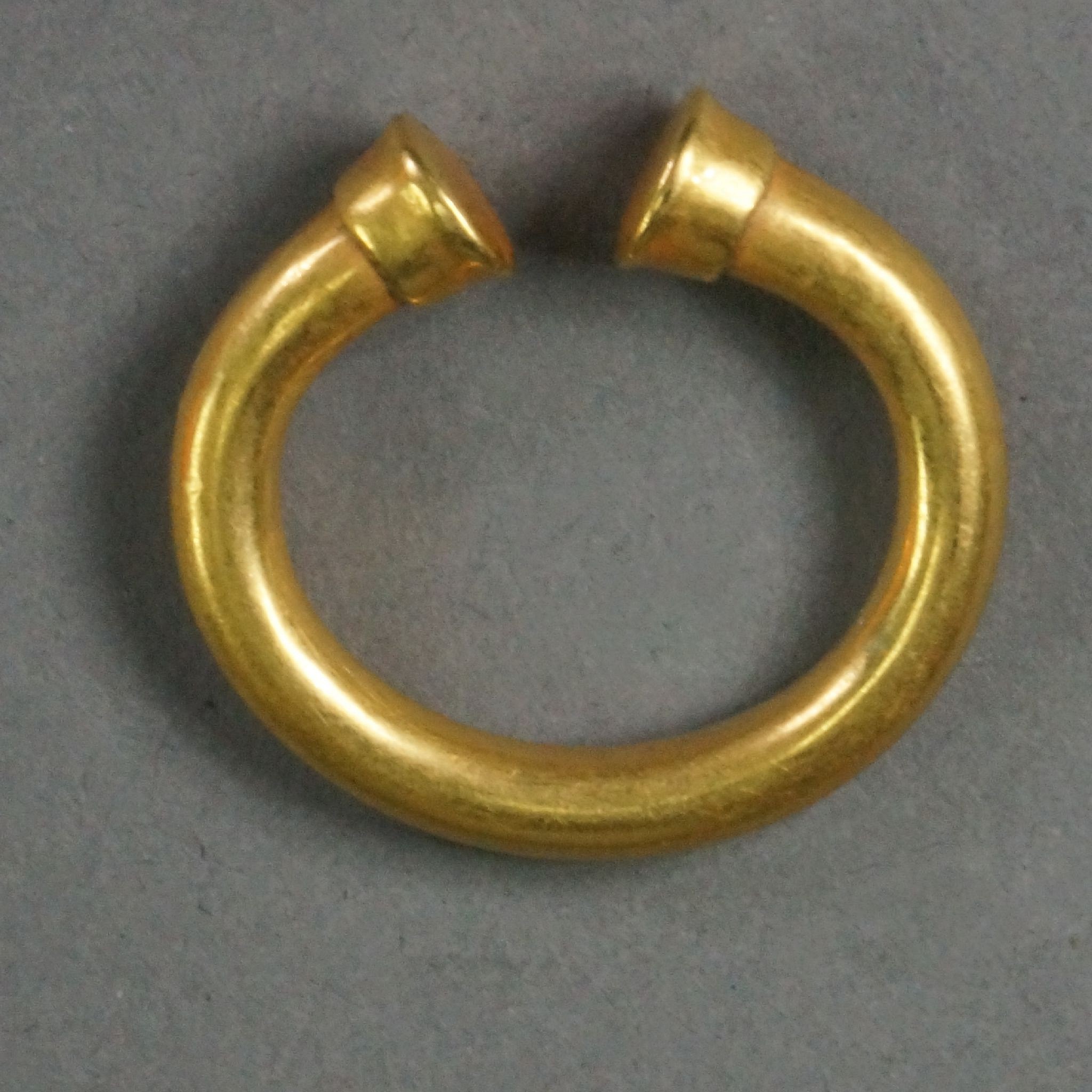
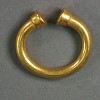
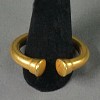
Colombia, Sinu Ring with Capped Ends
This high-karat, solid gold ring is has a lovely burnished finish. The cylindrical caps are typical of the Sinu, and are individually hammered onto the ends.
Period: Colombia, Sinu, Cauca River Valley, c. AD 700 - 1000
Media: Metal
Dimensions: Diameter: 1" 3/16" Weight: 16.4 grams
$2,500
n7034
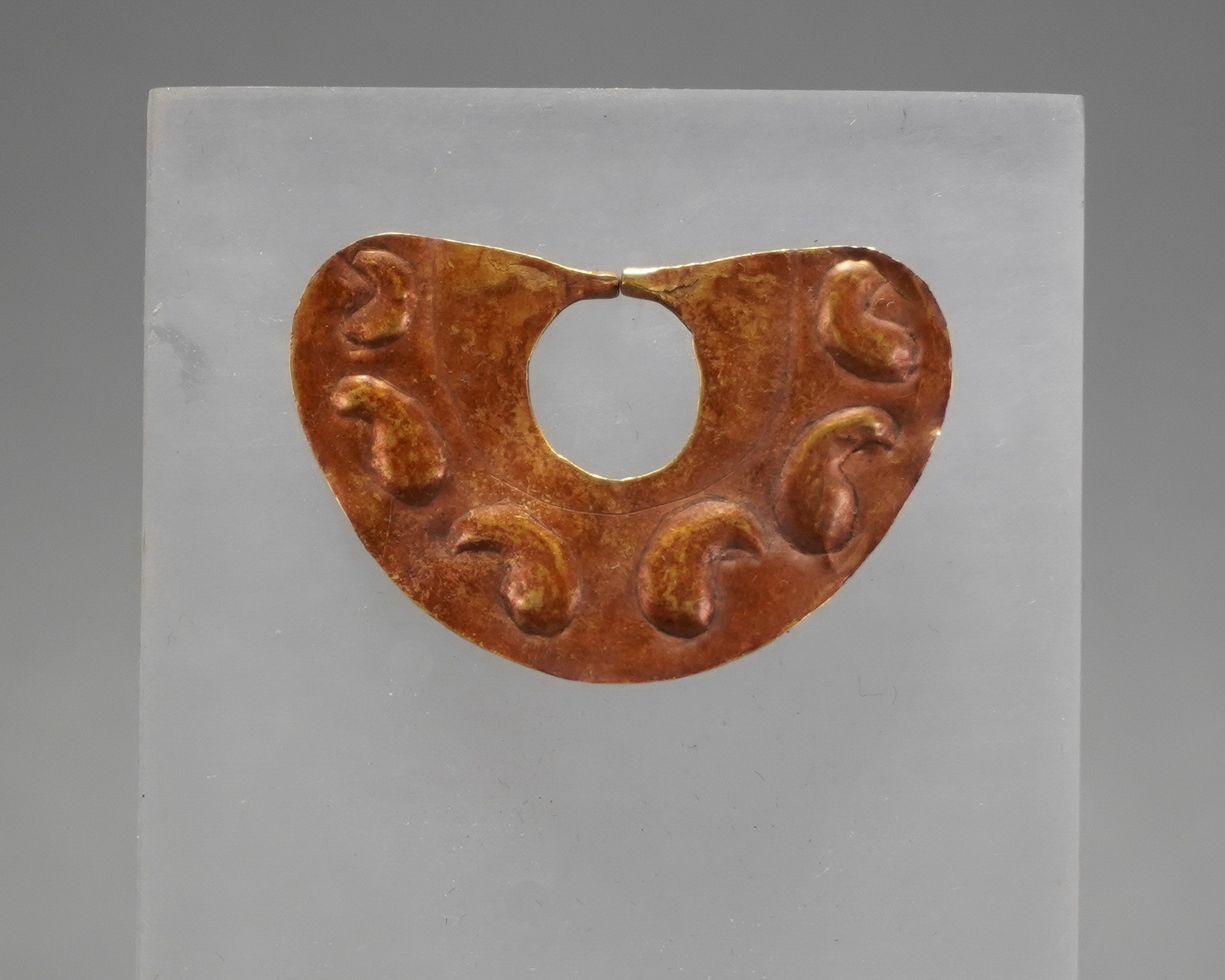
Peru, Moche Gold Nose Ornament with 6 Embossed Uculla Fruit
The Uculla fruit was an anti-coagulant to thin prisoners' blood for ritual ceremonies. The patina contains ferric oxide from the soil in the vicinity of the burial site, which gives the gold ornament its beautiful red patina. This piece was hammered from a soft sheet of pure gold. Small gold ornaments such as this required excellent craftsmanship to execute.
n9056
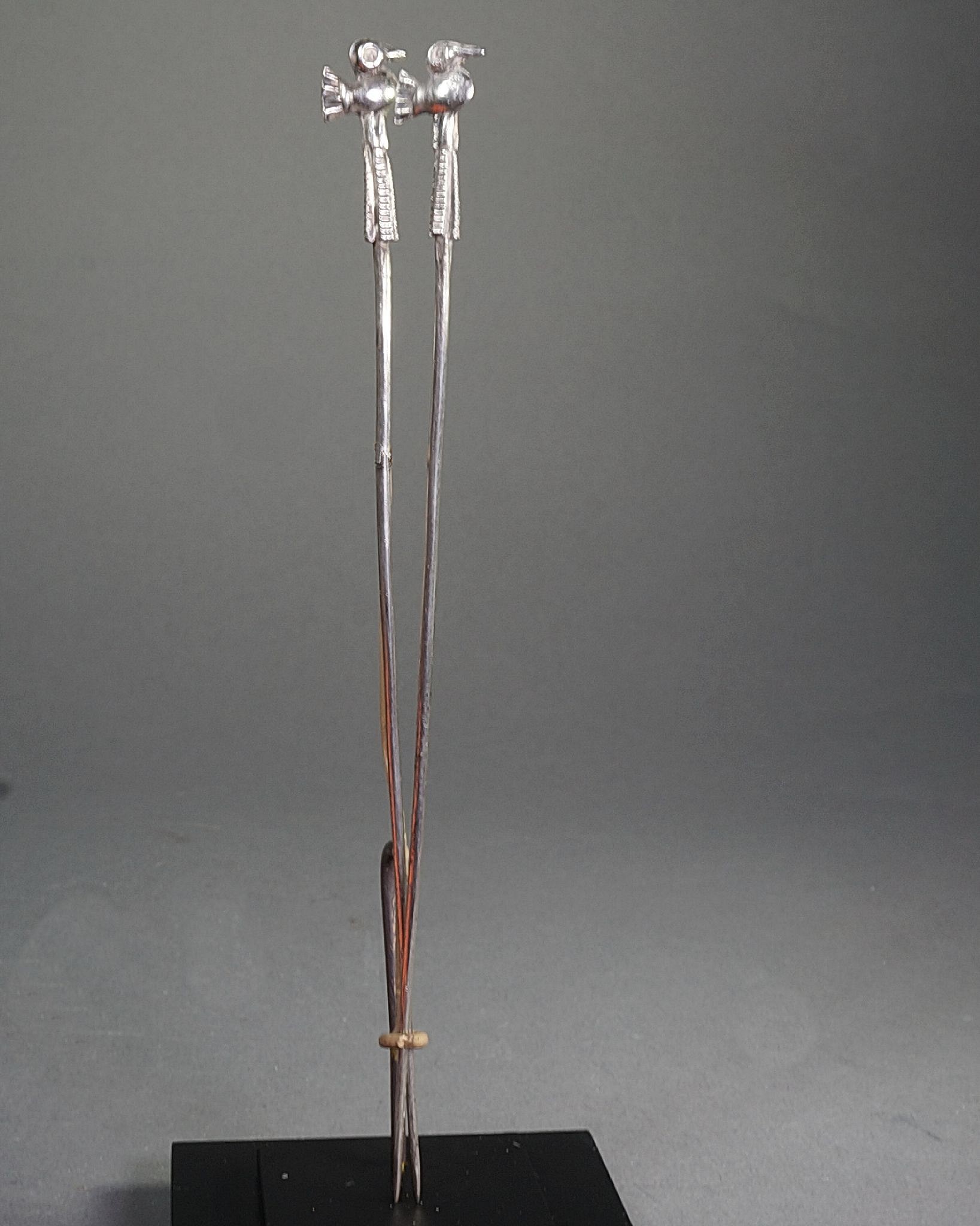


Peru, Pair of Silver Tupus with Identical Birds
Both silver birds created for this pair of tupus (garment fasters) are identical in structure and weight, which would have required great skill to execute. Each bird was made from a single flat sheet of silver, first cut out as a silhouette, then bent and rounded to create a three-dimensional form. The birds sit atop of corn stalks, which are in turn soldiered to the shafts of the tupus. The tupus shafts are made of solid silver.
Period: Peru, Chimu, North Coast, c. AD 900 - 1350
Media: Metal
Dimensions: Length: 5 3/4" x Weight: 4.4 grams each
$2,000
MM612
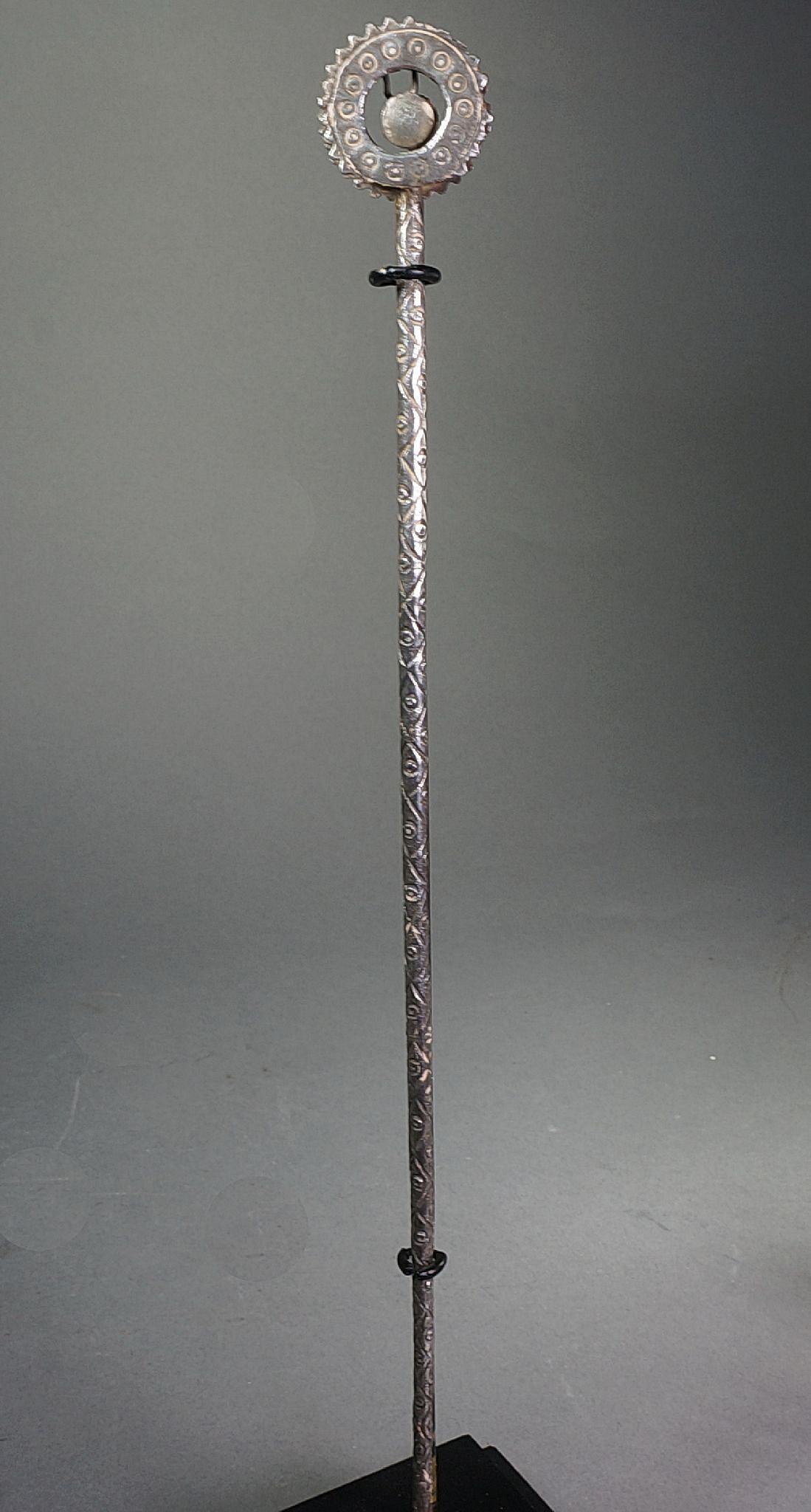




Peru, Chimu Silver Tupu with Ornate Rattle
Tupu pins were used by high status individuals to fasten their garments. The level of fine detail and craftsmanship indicates that this silver tupu would have belonged to an extremely important person. The shaft is completely incised with a repeating diamond motif. The rattle at the top is constructed with two incised discs, soldered to a curved band. Inside is a delicate suspended cylinder. This rare tupu is in good condition and has been professionally cleaned and stabilized.
Period: Peru, Chimu, North Coast, c. AD 900 - 1350
Media: Metal
Dimensions: Length:10" x Weight: 25 grams
$2,650
MM615
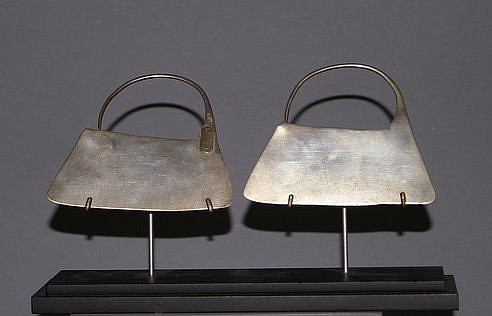





Chile, Classic Mapuche Trapezoidal Silver Ear Ornaments
This Mapuche ear ornaments are made from one continuous piece of hammered silver and feature the classic Mapuche trapezoidal shape. According to Mapuche tradition, these earrings would have been handed down to family members through multiple generations. They would likely have been repaired using primitive means by the family they belonged to.
Period: Chile, Mapuche, Tamuco Southern zone, c. AD 1890 - 1920
Media: Metal
Dimensions: Width 3 3/4: x Height: 3" Weight: 1.06 oz.
$2,900
M9042
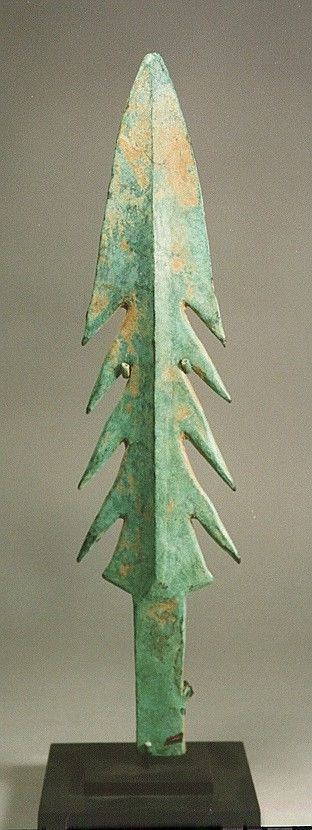


India, India- Gangetic Bronze Harpoon Point
A classic example of a Gangetic bronze harpoon point, which has been cast and chased with three additional sets of barbs. Ex Belgium collection prior to 1996.
Period: India, Gagentic period, Ganges River Valley, c. AD 100
Media: Metal
Dimensions: Height 11"
$2,750
94200a
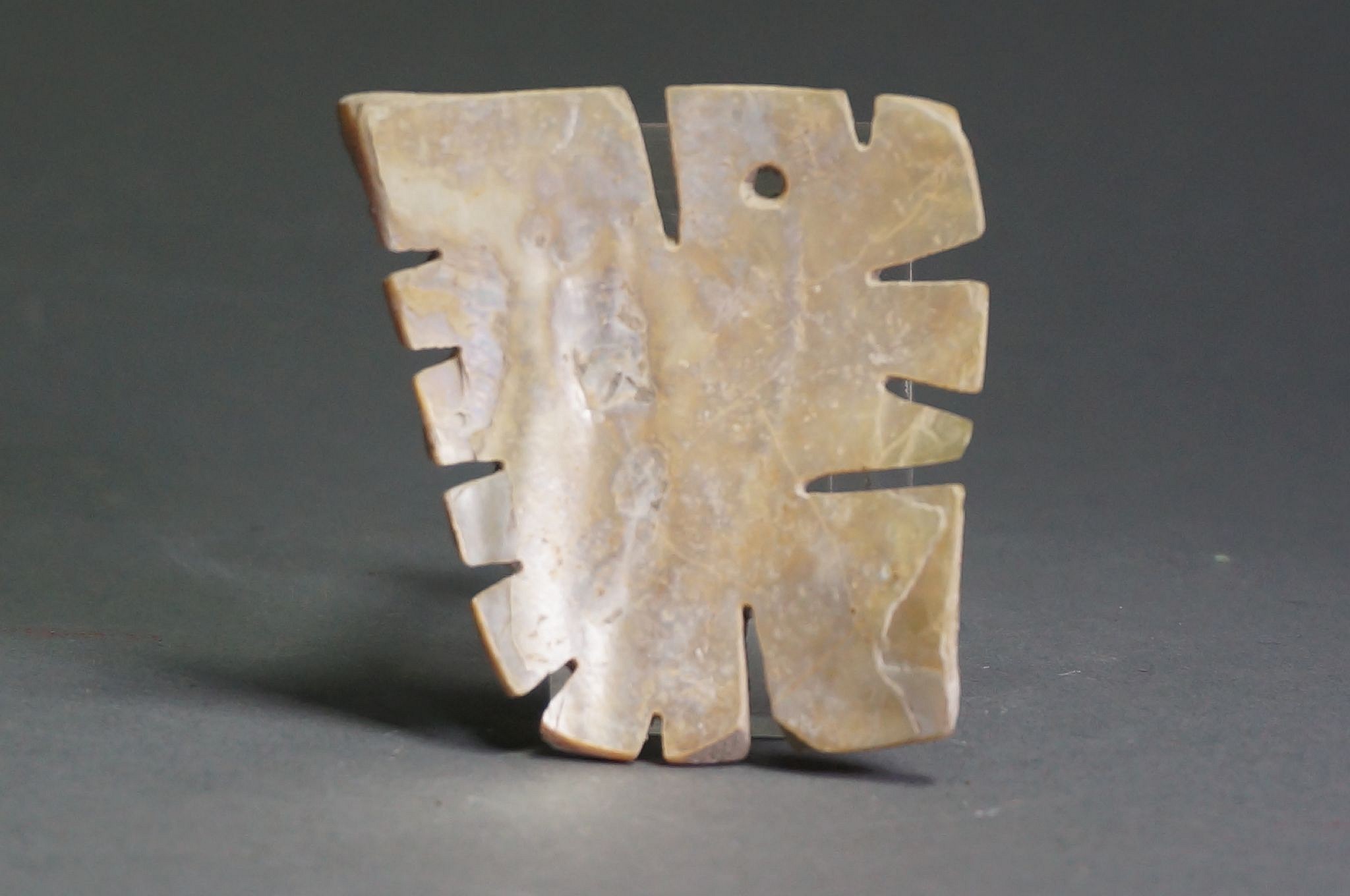






Ecuador, Guangala Carved Mother of Pearl Eagle
This exquisitely carved mother of pearl (Pinctada mazatlanica) ornament is abstract but retains a distinct ornithomorphic character of a bird in profile. It could be a harpy eagle which were important deities in Andean mythology. The suspension hole also serves as the bird’s eye, and the reverse side still has the remains of the shell's original. Considerably coveted as prestigious items by neighboring cultures, shells were found in abundance in the warm waters of coastal Ecuador and were essential to the economic development of coastal Pre-Columbian Ecuadoran trade. A similar zoomorphic example is illustrated in Valdez and Veintimilla’s, "Amerindian Signs 5,000 Years of Precolumbian Art in Ecuador," Ediciones Colibiri, Quito, 1992, fig. 63.
Period: Ecuador, Manabi, Guangala Phase, c. 500 BC - AD500
Media: Shell
Dimensions: Height: 2" (5cm), Thickness: 3 cm.
$1,800
94303
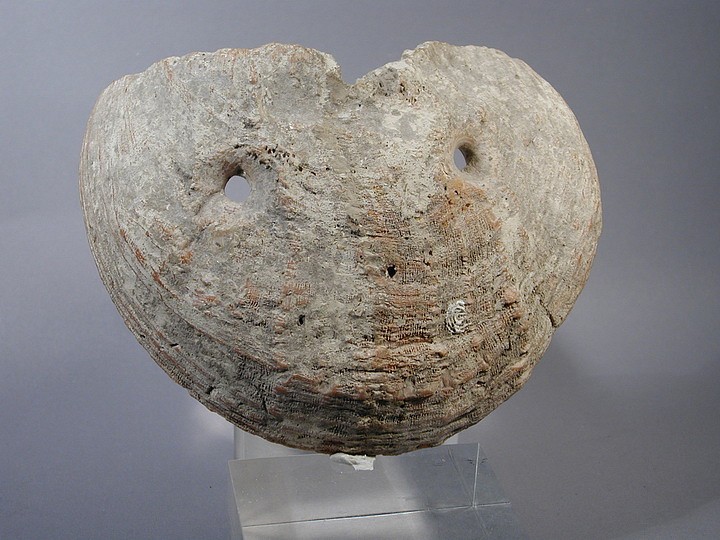


Ecuador, Shell Mask
This spondylus shell pectoral has been ground down to remove the exterior spines. Two drilled eye holes suggest eyes in a mask. This object is striking for its graphic simplicity, which never abandons the essential beauty of its primordial organic form: Spondylus princeps. Spondylus princeps are only found in the tropical north Pacific between the Gulf of California in Mexico and Ecuador’s Gulf of Guayaquil. Grave goods made from these shells have been found along the Andean coastline as far south as Chile. These goods are evidence of both regional exchange and long-distance trade. Spondylus shells from the north were traded for luxury items such as turquoise and lapis lazuli from the southern shores of Chile. The red rim of the spondylus shell was an especially valued material and was often cut away from the shell to be used in the production of other objects. Finely worked artifacts of organic origins are rarely preserved intact. A similar example is illustrated in Ancient Ecuador: Culture, Clay, and Creativity 3000-300 BC published by the Field Museum of Natural History, Chicago, 1975.
Period: Ecuador, Chorrera, 1500-1000BC
Media: Shell
Dimensions: Diameter: 5 3/4"
$2,500
94227
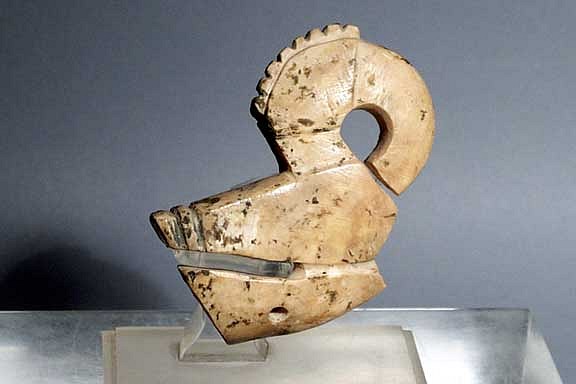


Colombia, Tairona Shell Macaw
Carved from a very thick shell with a hole in the base indicating that it was used as a finial for a staff. The bird has a large round beak indicating that it is a Macaw. Complete and intact. It is unusual for shell artifacts from Colombia to last so long.
Period: Colombia, Tairona, c. AD 1000 - 1500
Media: Shell
Dimensions: Height 2 1/4"
$1,450
88031a
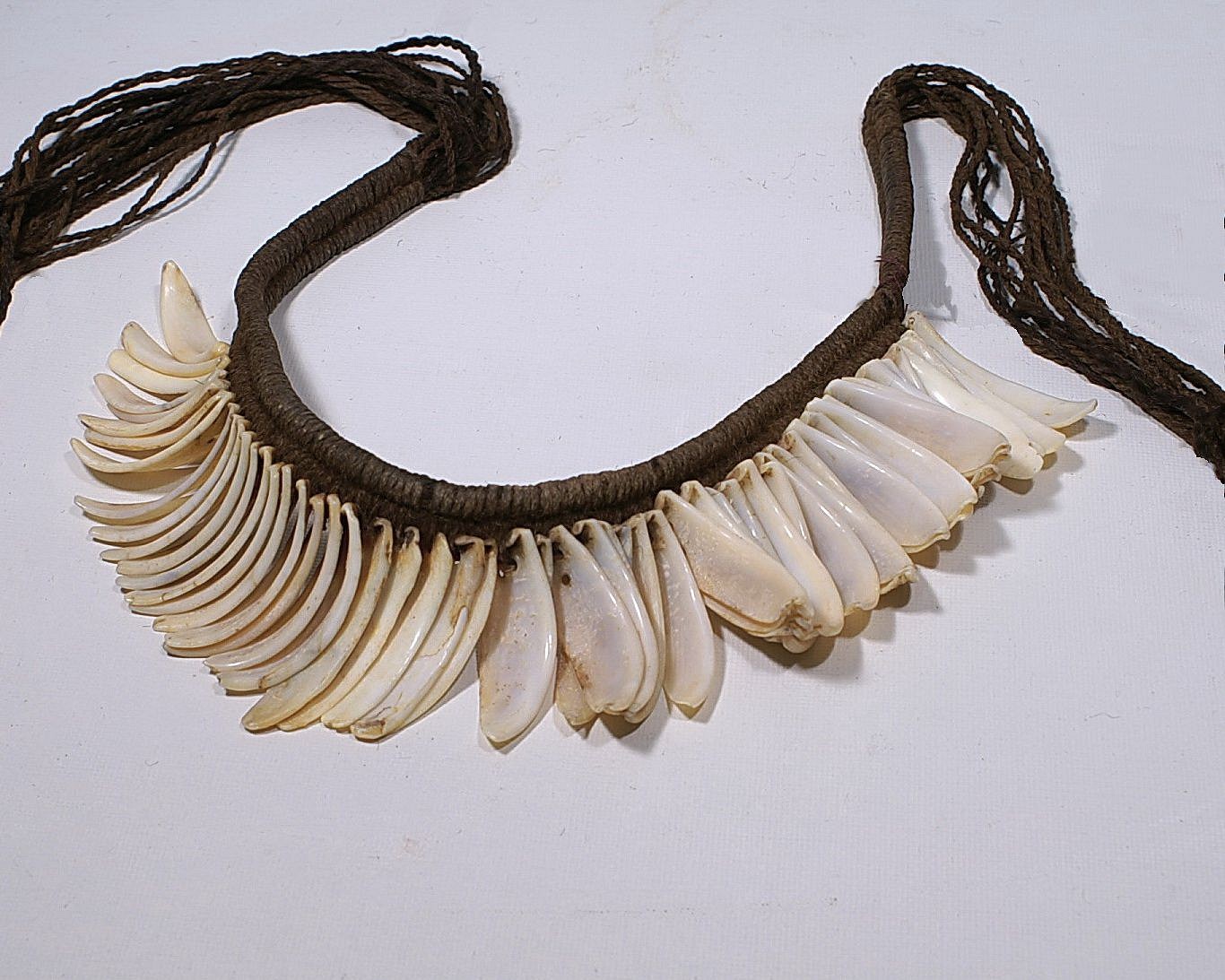




Peru, Nazca shell Necklace on Original Alpaca Cord
It is very rare to find a shell necklace with original stringing intact. This necklace is an excellent example of the Nasca culture's ingenuity in using the local marine resources. Each of the 55 shells is intricately tied to an elaborately knotted foundation cord. The shell appears to be a mussel or razor clam. A similar necklace is in the American Museum of Natural History.
Period: Peru, Nasca, South Coast, c. AD 400 - 800
Media: Shell
$3,200
99177
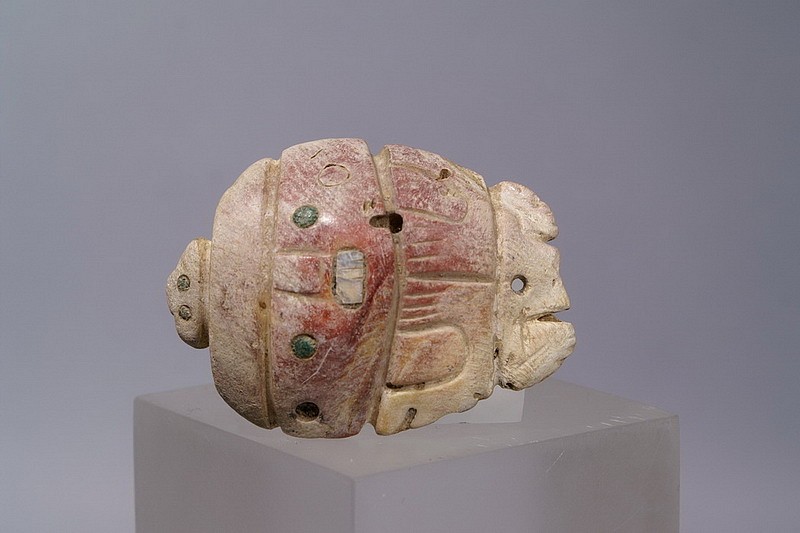


Peru, Chimu Shell Turtle Pendant
This turtle head and carapace have inlays of turquoise and mother of pearl. This is an unusually large shell, carved with double imagery. A human figure appears on the carapace when the pendant is vertical. When horizontal, the shell appears as a turtle, with a small head at the top, and tail and rear flippers at the bottom. From a Private New York collector prior to 1980's. Published in Ocean Fishing in Pre-Columbian Chile and Peru, plate 60.
Period: Peru, Chimu, North Coast, circa AD900-1350
Media: Shell
Dimensions: Height: 3" inches
Condition: As found with original inlays.
$2,900
M8027
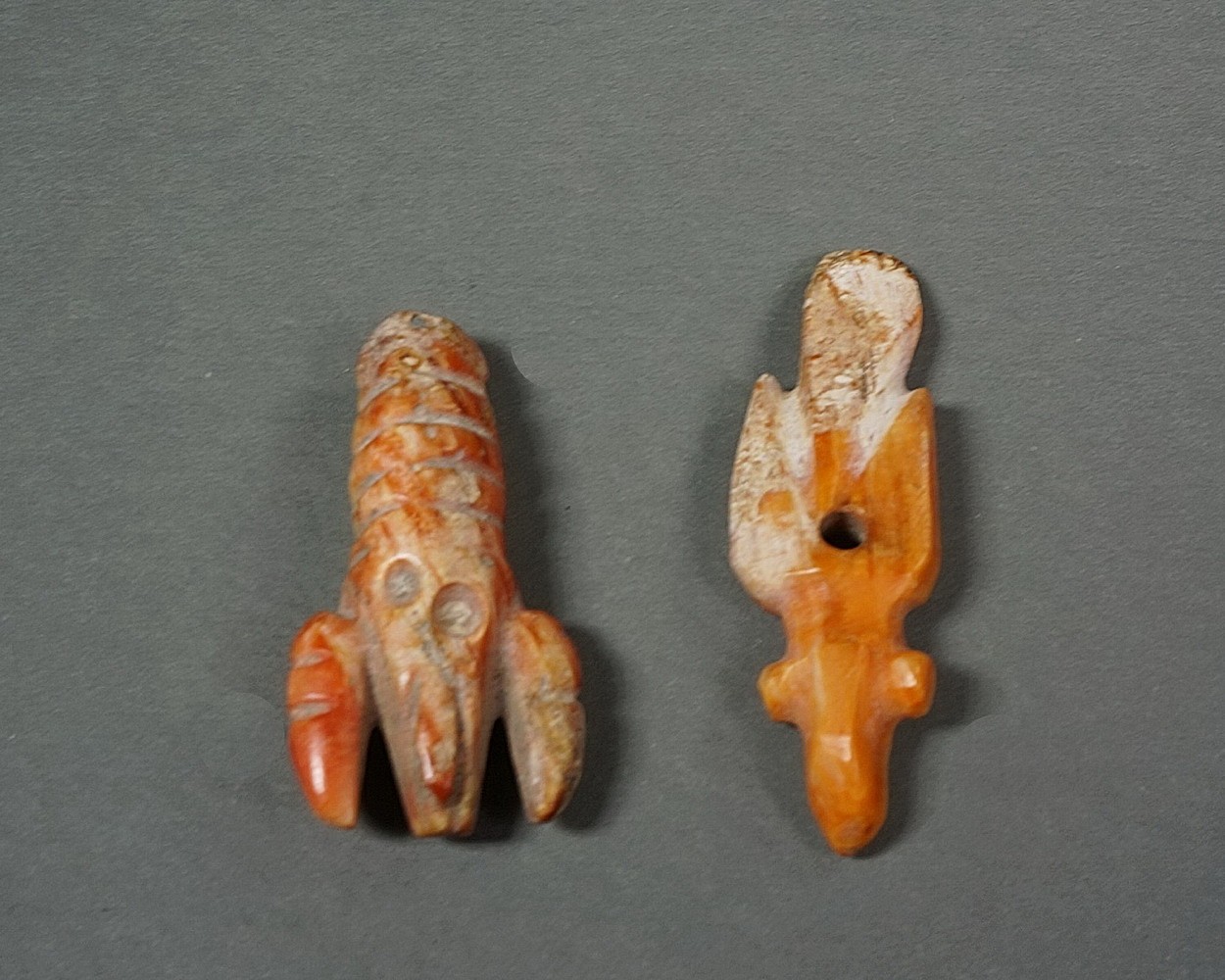




Peru, Chimu Carved Crayfish and Bird Pendants Carved from Spondylus Shells
The pendant on the left depicts a crayfish, while the one on the right represents a marine bird. Crayfish are found in the fresh water rivers along the Peruvian coast. Both pendants have suspension holes for attachment to a bracelet or necklace. Best seen from above, the bird has protruding eyes and a long tail. Both items are the types of Spondylus artifacts that are found on Peruvian North Coast Capa Pacha (child sacrifice ceremony). This is in discussed in PYRAMIDS OF TUCUME- The quest frof the Peru's Forgotten City by Thor Hyerdahl and Daniel Sandweisspg,106-112
Period: Peru, Late Chimu, North Coast, c. AD 1100-1530
Media: Shell
Dimensions: Crayfish Length: 1 3/8"
Bird Length: 1 1/2"
$1,250
N7002
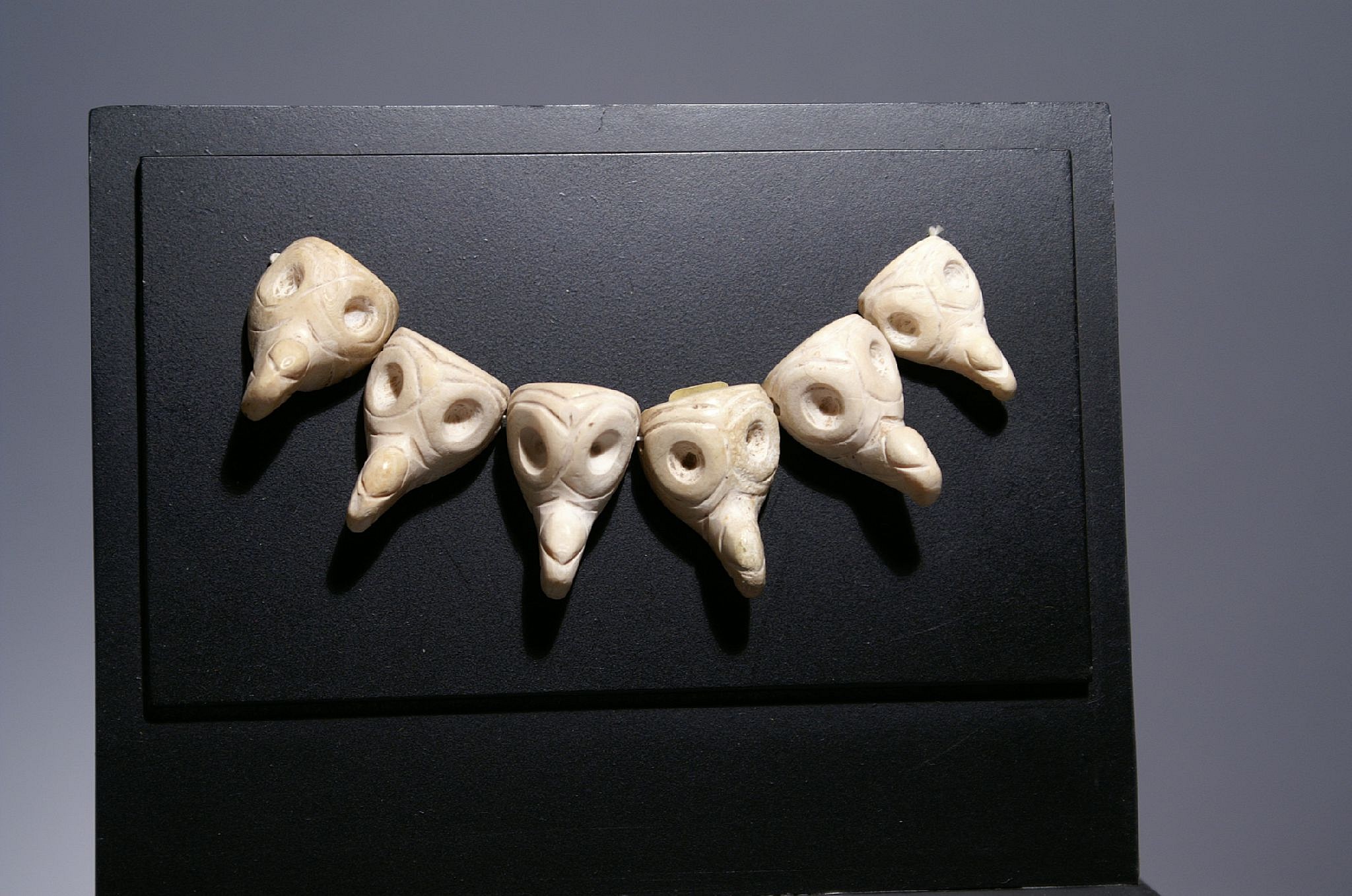


Mexico, Six Huastec Carved Shells in the Form of Condor Heads
These raptorial bird heads were clearly a part of the same original necklace. The bird may represent the condor, an endangered species in Mexico, or another powerful raptor that had mythological significance. Each shell head was drilled in the back with two conical drill holes. Colorado collector prior to 1997.
Period: Mexico, Huastec, Veracruz, c. AD 900 - 1500
Media: Shell
Dimensions: Length 4 1/2" Each head Length: 1"
Price Upon Request
97162
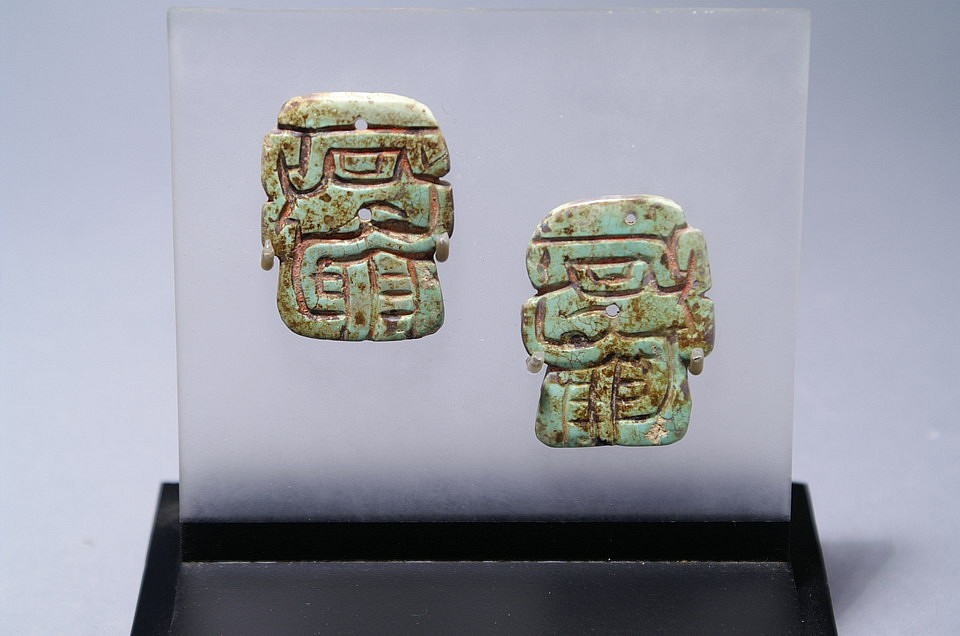
Peru, Chavin pair of Turquoise Plaques with Profile Faces
These faces could be trophy heads. There are two small drill holes center arranged vertically. It’s quite rare to find carved turquoise when most are made of shell. These may have been use as pendants to a textile. There is an abundance of manganese patina on the front.
Period: Peru, Chavin, Middle Phase, c. 1000 - 700 BC
Media: Stone
Dimensions: Height: 1 1/2" x Width 1 3/4"
$2,900
98046
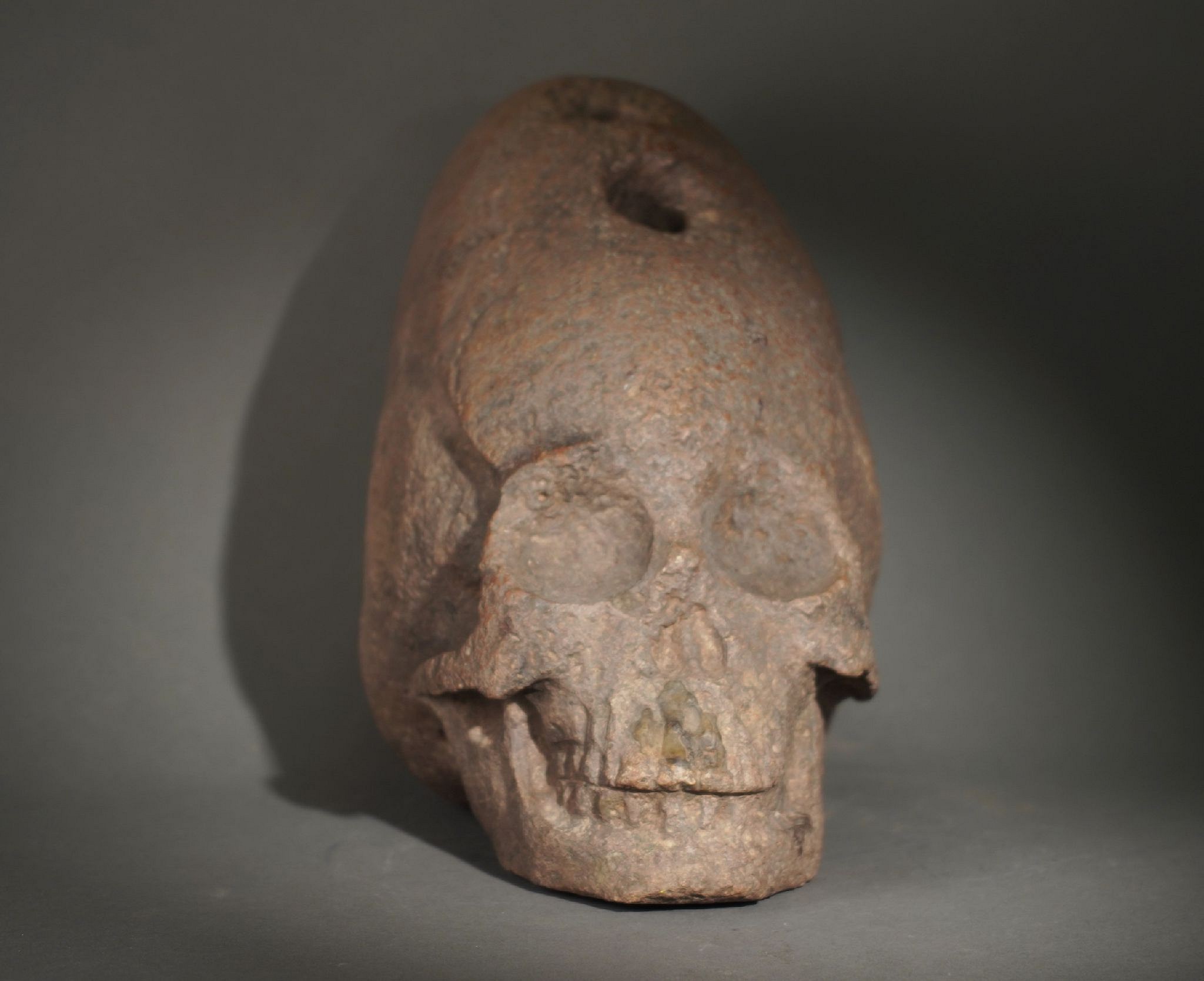
Peru, Official Archaeological Replica of Nasca Elongated Trophy Head
Some Andean cultures including the Paracas and Nasca would keep the skulls of enemy tribal leaders killed in battle as trophies of war. This late 19th century model is an exact replica of an elongated Paracas style trophy head which was dated circa 300 B.C. In keeping with the Paracas style, this trophy head has a set of suspensions holes on top. These holes would have allowed the victorious party to suspend a cord through the two holes for the purpose of displaying the trophy head as a sign of military and spiritual power. The ancient Andeans believed that the victor in battle acquired the spiritual properties of the enemies he killed. Authorized for export by the Peruvian government in 2011, with an official sticker at the base.
Period: Peru, South Coast, Late 19th Century
Media: Stone
Dimensions: Length: 11-1/2" x Height 7- 1/2"
$3,500
p1058
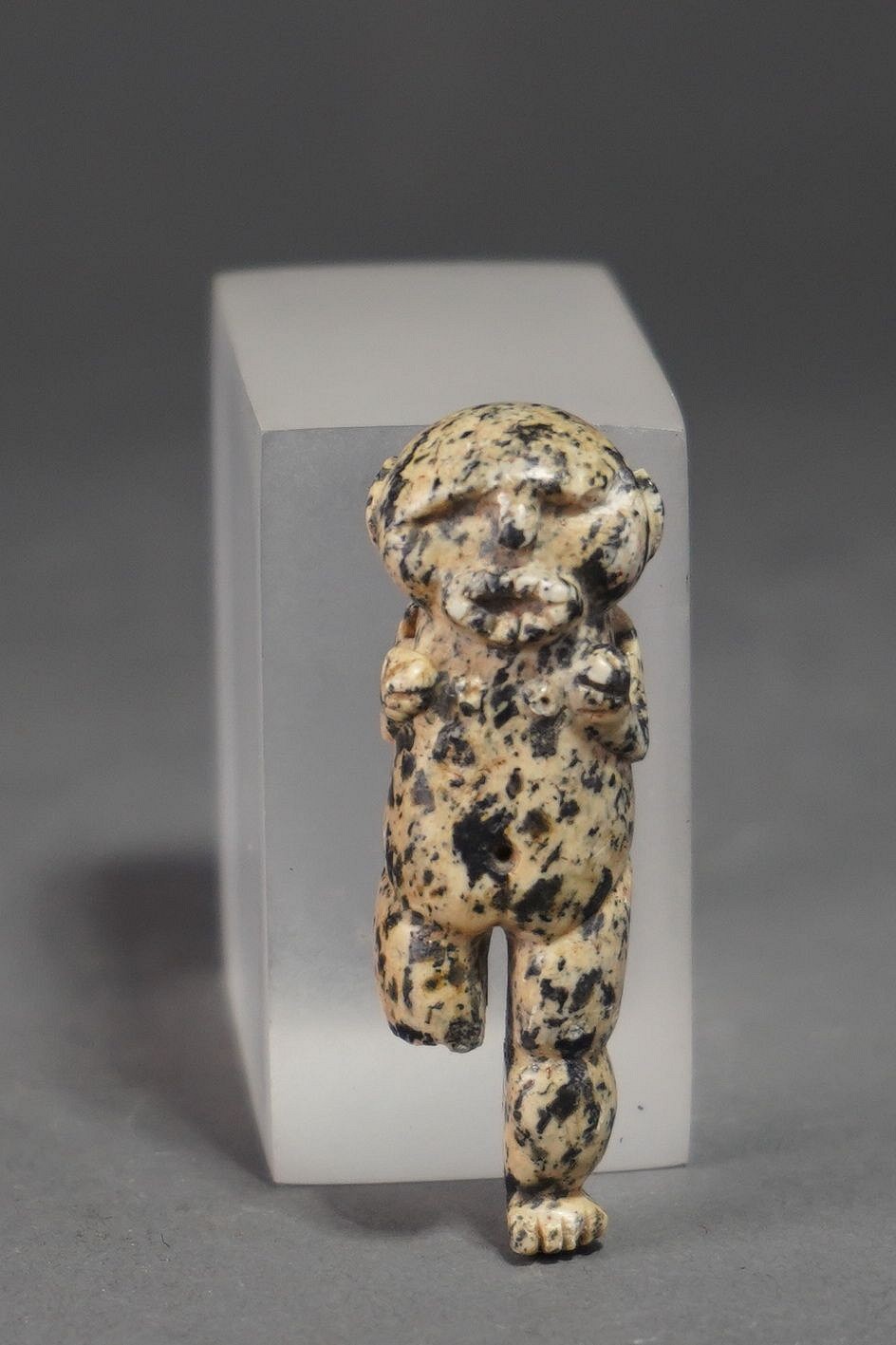




Panama, Veraguas Speckled Stone Pendant
This rare Veraguas anthropomorphic female bat deity bears a human body, a simian face, and bat-like ears. There is a suspension hole near each shoulder for hanging the pendant on a string. This pendant was exhibited in the Brooklyn Museum and published in the Jay Leff Collection, catalog no.500. Acquired from Sotheby's, May 12, 1983, lot 13.
Period: Panama, Veraguas, c. AD 800 - 1500
Media: Stone
Dimensions: Height: 2.25"
$1,800
88048b
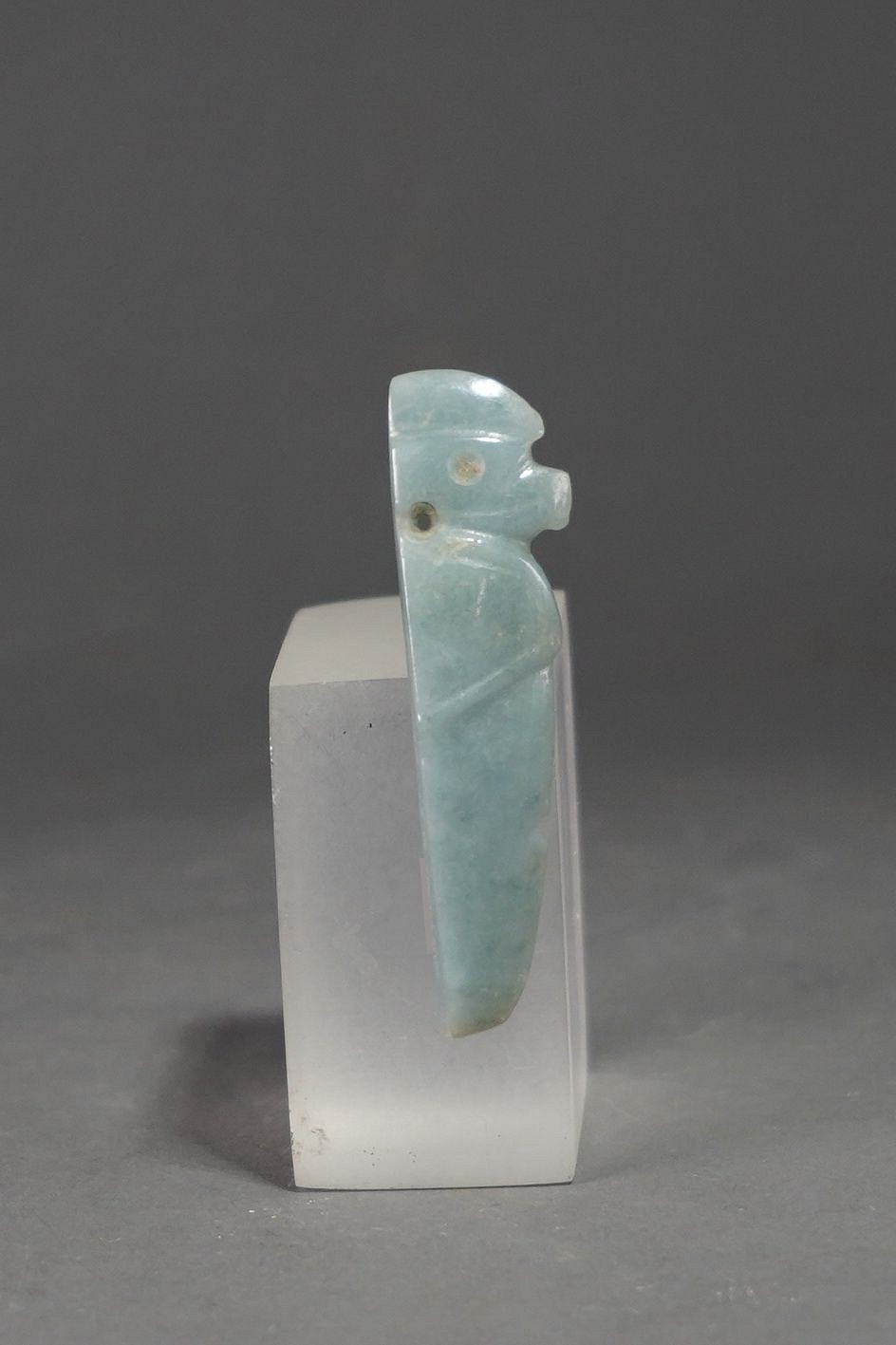



Costa Rica, Costa Rican Jade Harpy Eagle Deity Amulet
The harpy eagle is one of the most feared birds in Costa Rica. This translucent, speckled jade stone eagle is carved to show the wings and beak on both sides. One side is slightly convex and the other slightly concave. There is a suspension hole by the neck.
Period: Costa Rica, Linea Vieja, Atlantic Watershed, c. 1 AD - 500
Media: Stone
Dimensions: Length 2 5/8" x Width: 3/4" Thickness 1/4"
$975
M3060
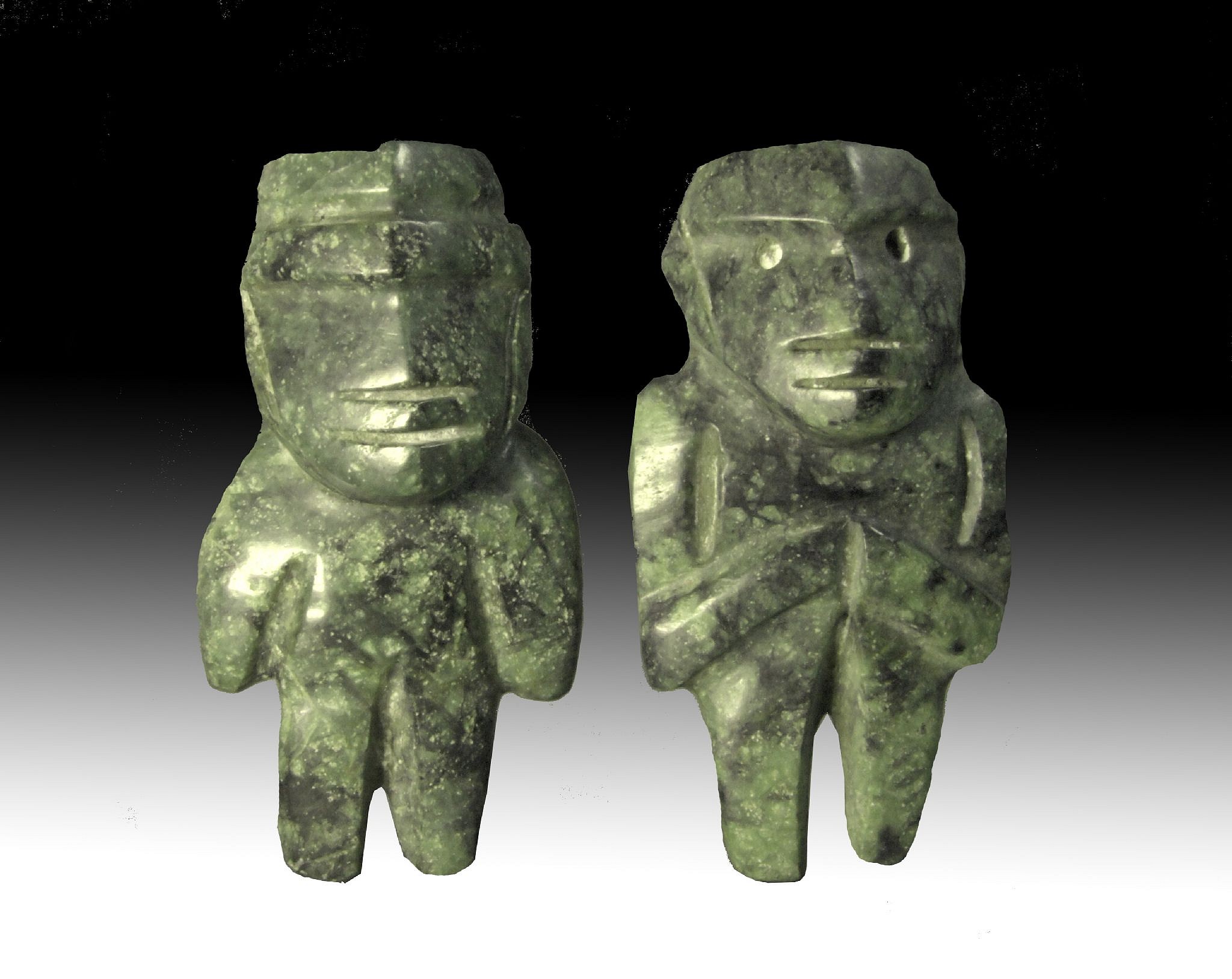








Mexico, Pair of Miniature Dark Green Jadite Mezcala Figures of the M16 Type
These miniature dark green jadite figures, male and female, bear serene facial expressions and body language. The figures were created using the string-sawing technique and are made of an extremely smooth and dark jadite native to South America, characterized by a network of deep green and blue-black veins. The figures have complex faces and arms that stand out in relief, which makes them category Type M16 Mezcalas. The representation of human figures played an important role in Mezcala culture, including in rituals and burial sites. Its rare to find a male and female made as a pair. For a reference see the Primitive Museum of Art's MEZCALA STONE SCULPTURE: THE HUMAN FIGURE, p.22-23, and MEZCALA: ANCIENT STONE SCULPTURE FROM GUERRERO MEXICO, by Carlo Gay and Frances Pratt, plate 61. Ex. Gallery Hana-Tokyo, prior to 1970.
Period: Mexico, Mezcala, Guerrero, c. 1200 - 300 BC
Media: Stone
Dimensions: H: 2.5 in. x W: 1.25"
Price Upon Request
n5058



Peru, Paracas Miniature Knitted Fringe or Neck Opening with Double-Headed Worms
Eleven finely knitted colorful segments depicting double-headed worms with curled tails in alternating colors. Below each worm is a small tab with an even smaller creature nested within. Acquired from the estate of Anton Roeckl in Germany prior to 1970.
Period: Peru, Paracas, Late Phase, South Coast, c. 300 - 200 BC
Media: Textile
Dimensions: Length: 6 3/4 inches
$2,800
96165
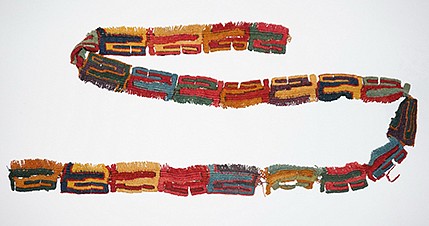





Peru, Knotted Textile Fringe with Colorful Abstract Motif
This knotted fringe is distinguished by its brilliant colors and abstract "z" motif repeated along the band. It was not woven on a loom but instead was created by a method referred to as "tubular looping." Looping is a single-element technique in which the free end and full length of the yarn are pulled through previous work at the edge of the fabric to form each new loop. Looping predates the domestication of fiber-bearing plants and animals and the invention of weaving in the Americas and possibly Eurasia. The choice of color combinations creates a vibrating impact.
Period: Peru, Nazca-Early phase, South Coast, circa AD200-400
Media: Textile
Dimensions: Length: 61 inches; Width: 2 inches
$3,000
91105
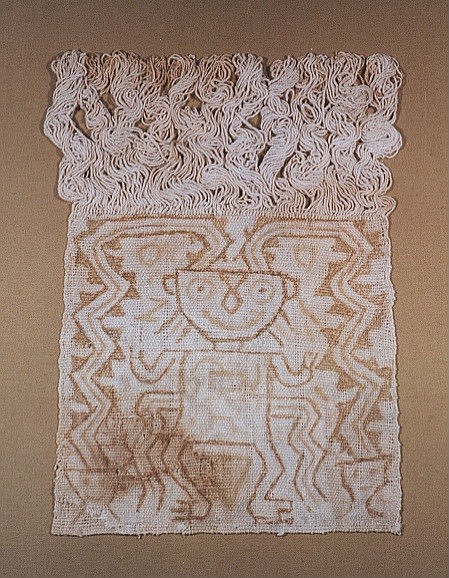
Peru, Paracas Painted Mummy Mask Textile with Figure and Serpents
The Paracas culture is known for its elaborate and whimsical painted textiles as well as its mummy masks, which were placed over the faces of the deceased. This cotton textile is woven in white thread and painted with varying shades of tan and brown pigment. The mysterious central deity is depicted standing with his arms and legs turned outward. Serpentine creatures emanate from either side of his head, their miniature faces resting at the ground near his feet. The cotton warps form a fringe along the top border. Ex. collection Pablo Soldi-Lou Slavitz in the US prior to 1960's.
Period: Peru, Paracas, Ocucaje Phase 9, Ica valley, South Coast, c. 300 - 200 BC
Media: Textile
Dimensions: Height: 16" x Width: 8"
$3,400
92005
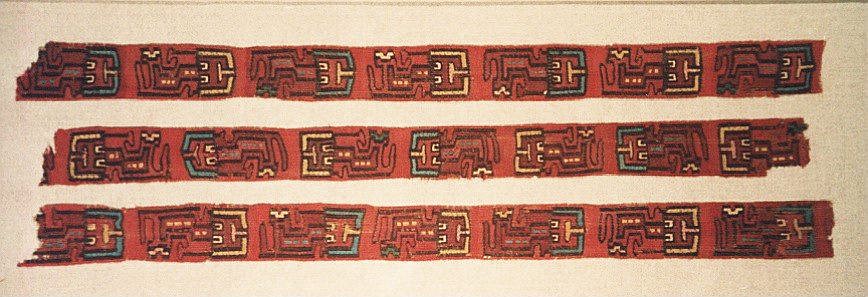


Peru, Nazca Border with 21 Abstract Feline Deities
A Nazca band decorated with seven abstract feline deities alternating in colors blue, yellow and maroon on red ground. The deities face upward, with hind legs and tails outlined in black. When the felines are rotates 90 degrees, they appear to be worms. A similar image is illustrated in Ancient Peruvian Textiles from the Collection of the Textile Museum, plate 17.
Period: Peru, Proto-Nasca, South Coast, c. 100 BC - AD 200
Media: Textile
Dimensions: Length: 20" x Width: 7"
$1,800
94178a
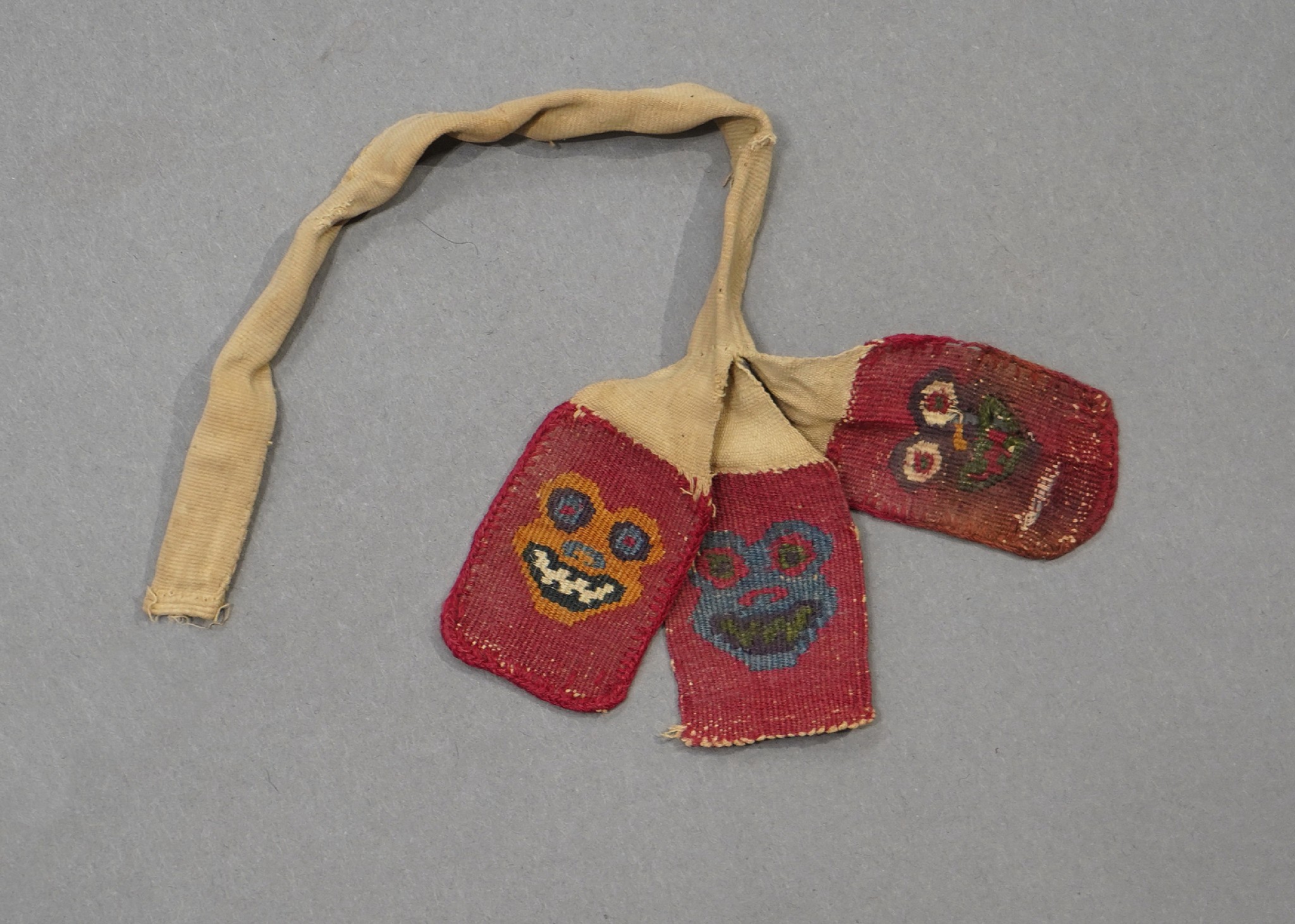
Peru, Three Wari Woven Tabs with Animal Heads
These woven tabs with stylized grinning toad faces were once part of a sash. The tabs are woven in orange, green, blue, white and black on a red ground. A similar set of tabs is illustrated in Animal Myth and Magic,by Vanessa Moraga, p. 110.
Period: Peru, Wari, South Coast, c. AD 600 - 900
Media: Textile
Price Upon Request
91095a
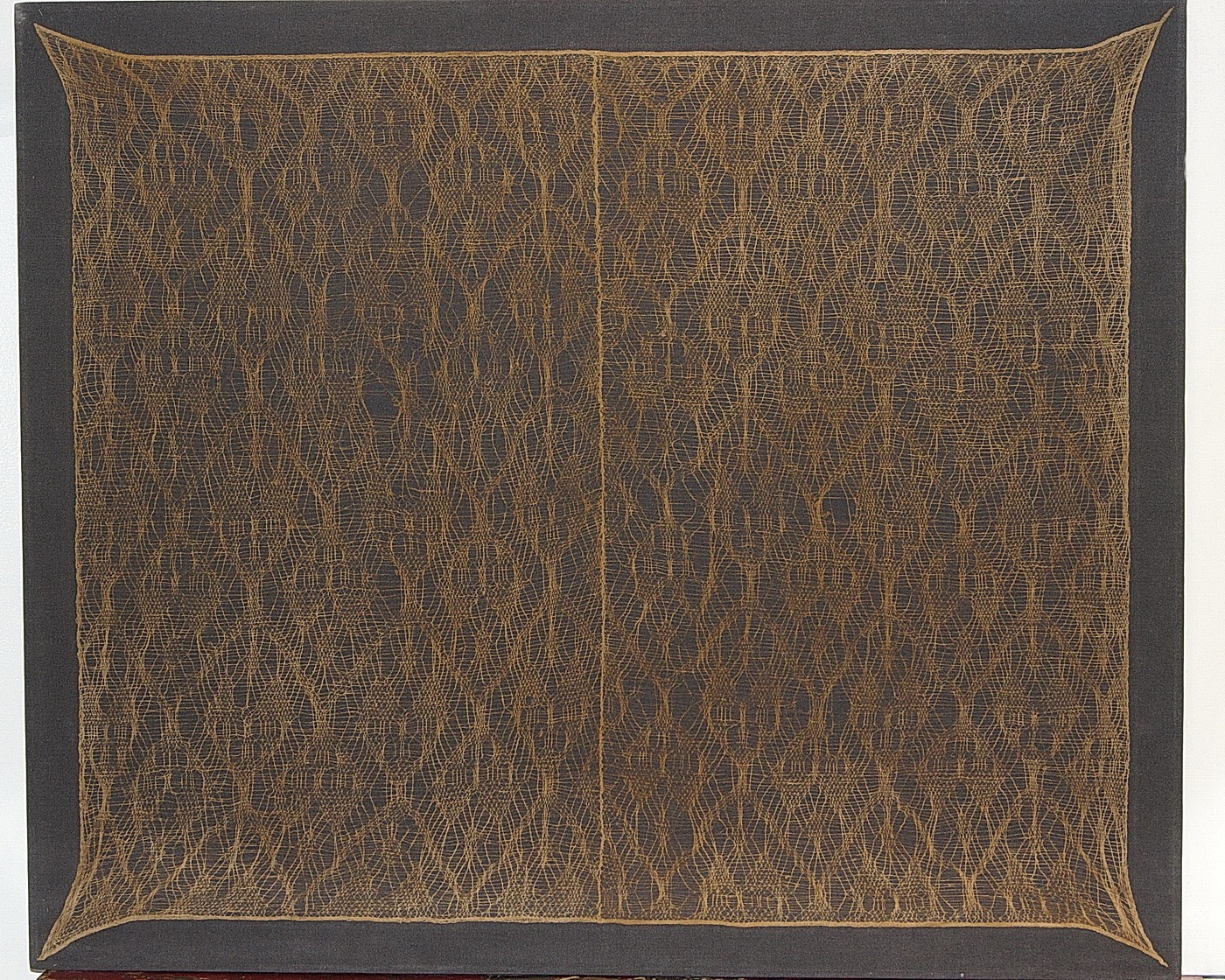
Peru, Chancay Tan Gauze Witch's Vail with a Complex Pattern of Cat Faces
Tan cotton complex gauze decorated with a lace-like pattern of cat faces in alternating orientations. Witches’ vails are often seen on Chancay dolls. This example has tightly spaced cat faces, making the gauze very dense and complex.
Period: Peru, Chancay, Central Coast, c. AD 1100 - 1430
Media: Textile
Dimensions: Height 38" x Width 32"
$3,350
94277A
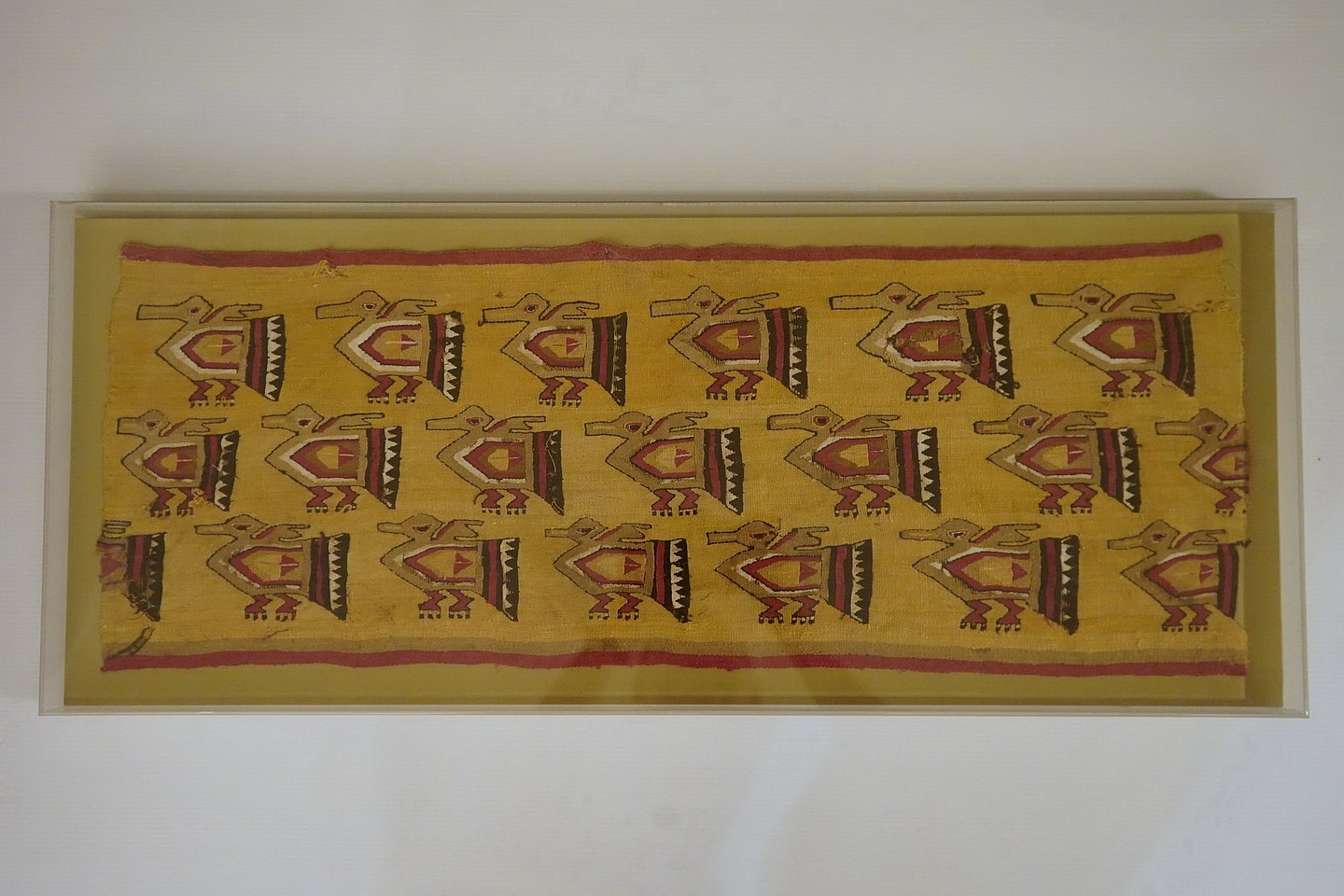


Peru, Chimu Tapestry Panel with 18 Ducks in Profile
This tapestry features 18 ducks in profile, and arranged in three rows, each oriented in the same direction. Each duck has one wing stylized in the shape of a single feather and the other behind its head. There is delicate detailing in the feet and tail feathers. The panel is mounted in a Plexiglas box. The framer used an adhesive to attach the weaving to the ivory cotton ground; it should not be removed from the stretcher.
Period: Peru, Chimu, North Coast, c. AD 900 - 1350
Media: Textile
Dimensions: Height: 13" x Width 31"
Price Upon Request
n9041



Peru, Chancay Fringed Tapestry Border with Cats and Birds
This was likely the border of a tunic and was made as two loom widths sewn together with an additional fringe sewn horizontally. The design of cats and birds alternating in angled bands is bordered above and below with rows of additional small birds. It is unusual to see such red and gold highlights dyed on cotton.
Period: Peru, Chancay, Central Coast, c. AD 1100 - 1430
Media: Textile
Dimensions: Width: 37" Height: 9"
$2,200
94277
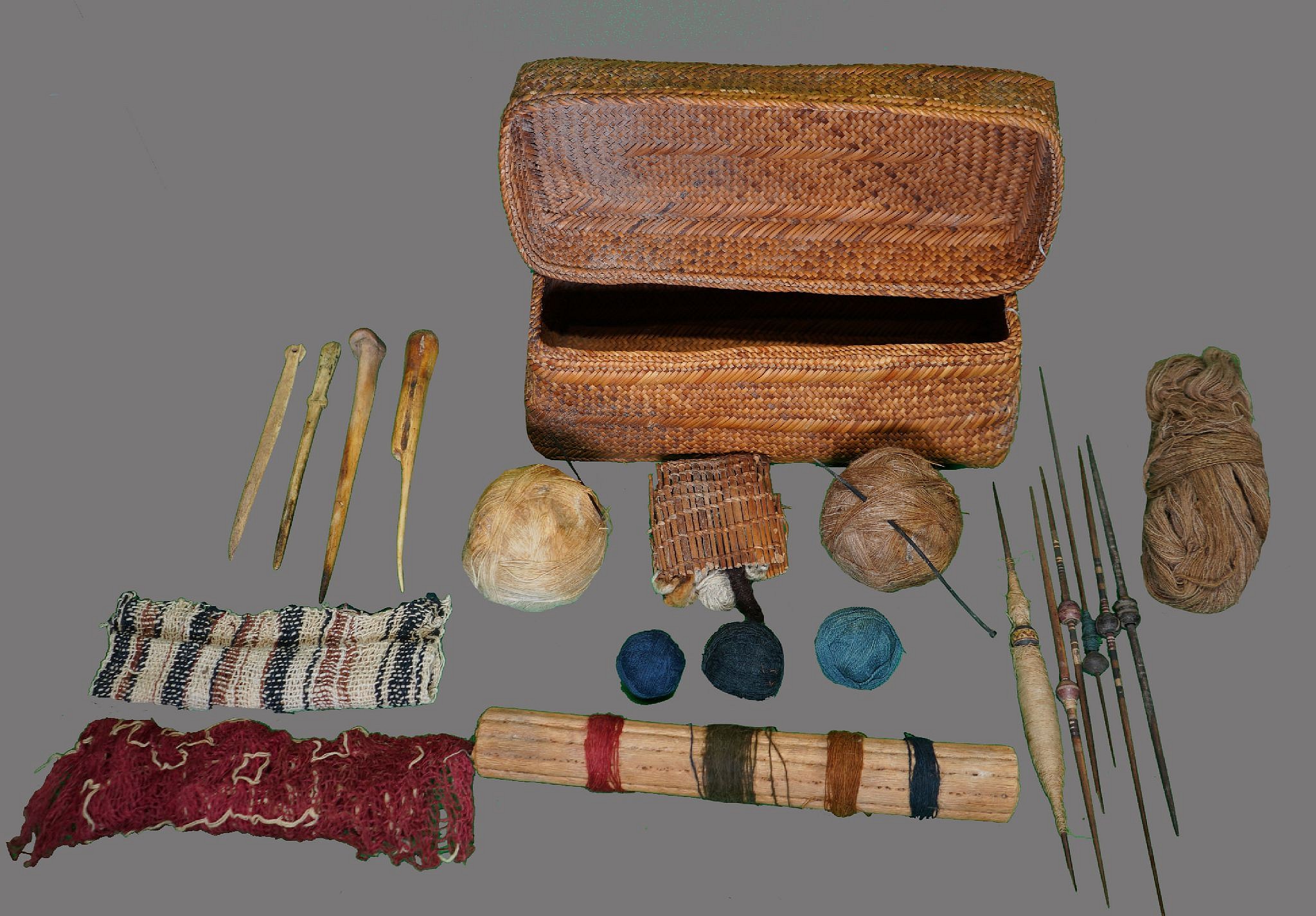
Chile, Chancay Basket with Weaving Implements
This rectangular reed basket with separate cover contains a complete ancient Peruvian weaving kit. The basket has bamboo ribs to support its shape. Based on the contents, it appears to have been used for weaving garments for Chancay dolls. The contents include: two large and three small wound balls of thread in a variety of colors, five spindle whorls, one bobbin, two thorn needles, two bone needles, a shed rod, and three small ancient woven panels. All the components are ancient and were found together in the basket.
Period: Peru, Chancay, Central Coast, c. AD 1100 - 1430
Media: Textile
Dimensions: H. 4 3/4 x L. 11 1/2 in.
Price Upon Request
91272
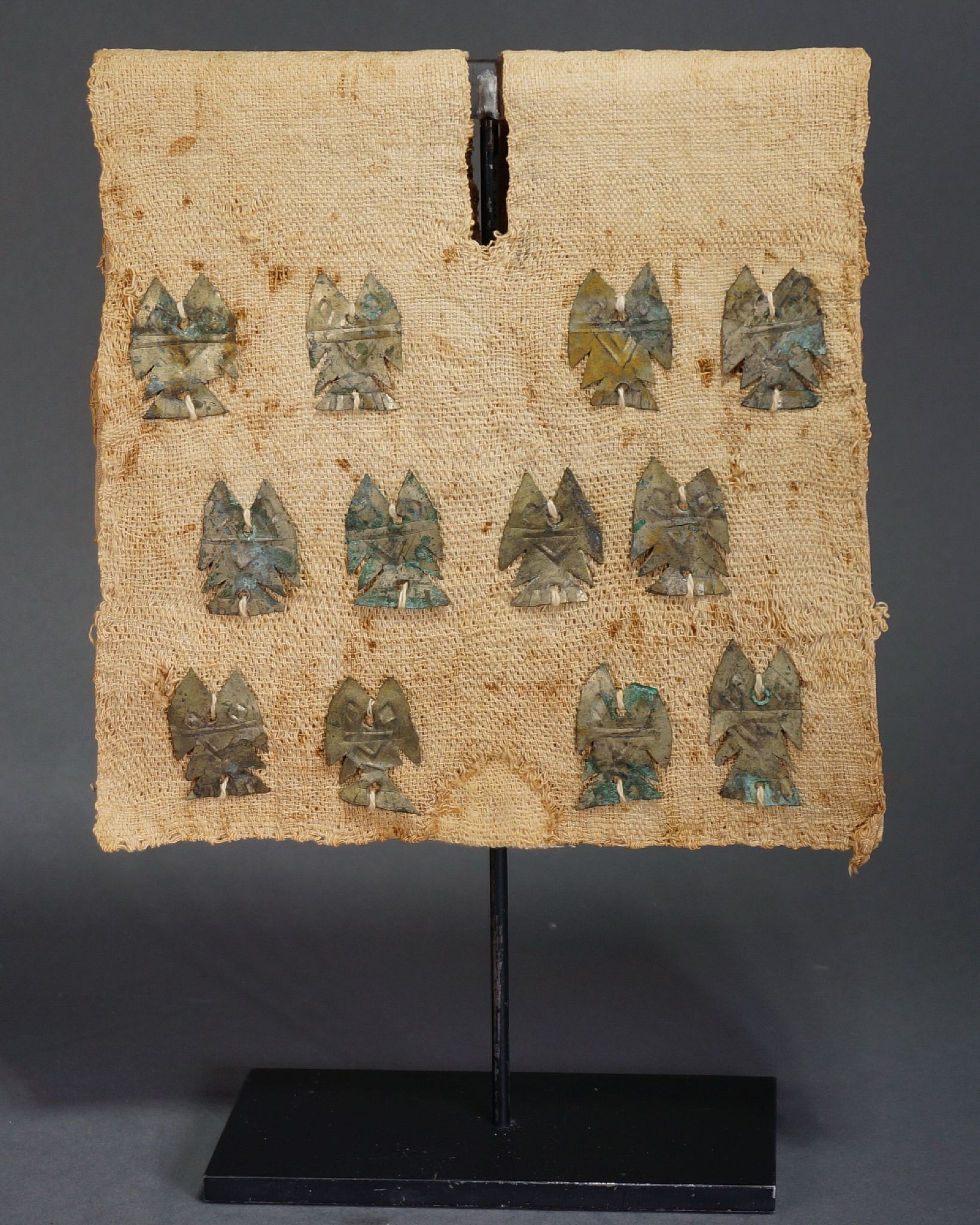


Peru, Miniature Tunic with Fish Appliques
This rare small tunic was made for a child or perhaps a doll. The silver fish are individually crafted - cutout with repousse details. The fish are attached with the original thread, through holes in the fish, and are applied to both the front and back of the tunic. The Metropolitan Museum of Art in New York possesses a similar miniature tunic, pair of shoes, and coca bag, all made in the same style using textiles with square-shaped silver appliques. These items, along with a larger textile, are illustrated in the Textile Museum's publication Costumes and Featherwork of the Lords of Chimor, figs. 148, 167,168.
Period: Peru, Chimu, Central Coast, c. AD 900 - 1350
Media: Textile
Dimensions: Width: 7" x Length: 13 1/2"
$2,500
91201A

Peru, 3 Inca Slings
These three slings double as tethers and were used to restrain llamas by attaching them through a hole in the ear. Llamas were herded by the Incas and were the primary source of cargo transport in the Andes. A llama could carry up to ninety pounds of cargo on its back.
Period: Peru, Inca, South Coast, c. AD 1200 - 532
Media: Textile
Dimensions: mounted dimensions: H. 36 x L. 17 in.
$3,000
89505A
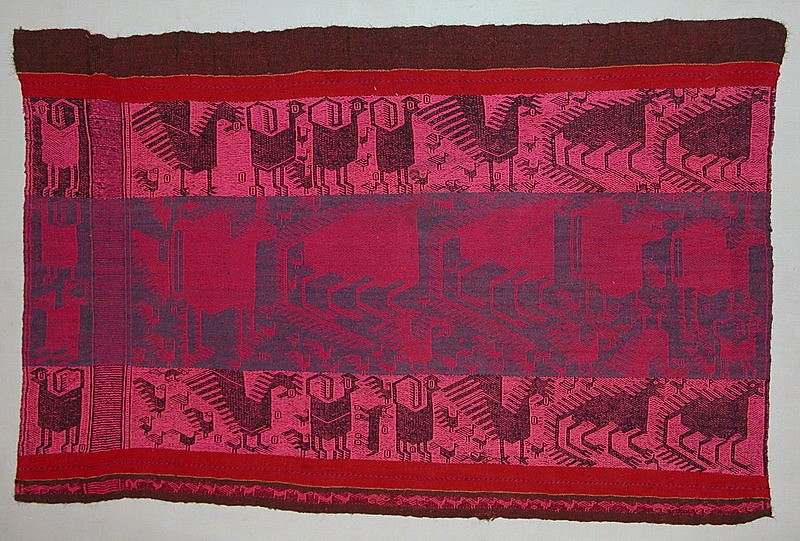
Bolivia, Potolo Llacota Mantle with Mythical Animals in Pink and Blue on Maroon Ground
These fantastic animals, demons and monsters are unique to Potolo. These creatures and are said to be envisioned by young women who participate in a ritual that involves spending the night in a cave, likely while using entheogens. This coming-of-age ritual and the visions of demons and strange animals are considered a part of the young Potolan woman’s passage from childhood into adulthood. Potolan weavings, and the animals they portray are associated with sexuality and fertility. Mounted on a stretcher.
Period: Bolivia, early 20th century
Media: Textile
Dimensions: Width 39" x Hieght 29"
$2,900
89256
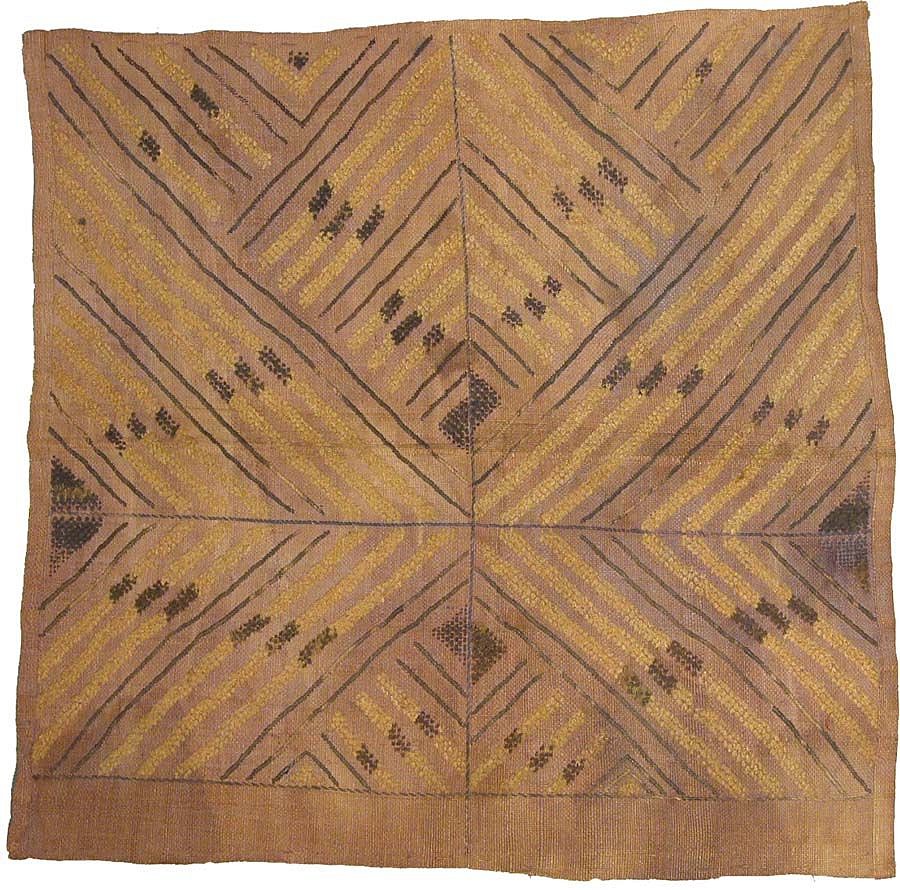


Zaire, Dekese (Kuba Kingdom) Raffia Panel with X-shaped Motif
Woven palm-leaf fiber panel embroidered with four variations on the same V-shaped motif which intersect to form a large “X.†The panel was embroidery cut to form a pile surface, resembling velvet. This panel was brought back by one of the members of H.M. Stanley's famous expedition to Central Africa in the late 1800's.
Period: Congo, Kuba, 20th Century
Media: Textile
Dimensions: Length 23.5" x Width 23.5"
$450
M4089
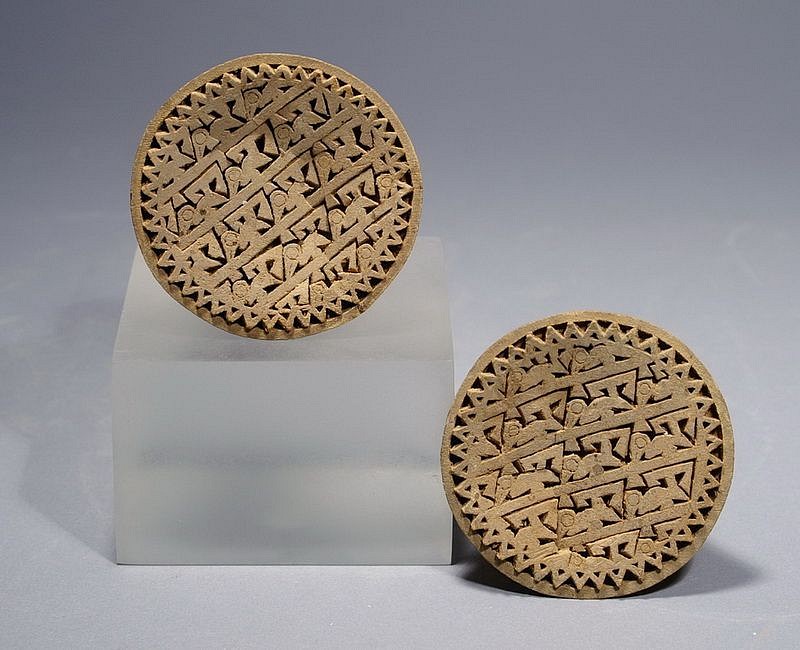



Peru, Central Coast Peruvian Wood Ear Spools
Probably late Huari or early Chancay, these light balsa wood ear spool carved in three sections, depicting a face, body and back. The design is cut out, with four rows of birds in profile – generally typical of Chancay or Chimu art. No glue or tree resin was used to keep the three sections together, rather they are carved perfectly to have a precise fit. Ear spools were used in the ancient Andes to display status and rank. Ex. Daniel Rifkin, acquired in New York prior to 1980.
Period: Peru, Wari, Central Coast, c. AD 650 - 1100
Media: Wood
Dimensions: Diameter: 3" x Depth: 4 1/2"
Price Upon Request
M4011
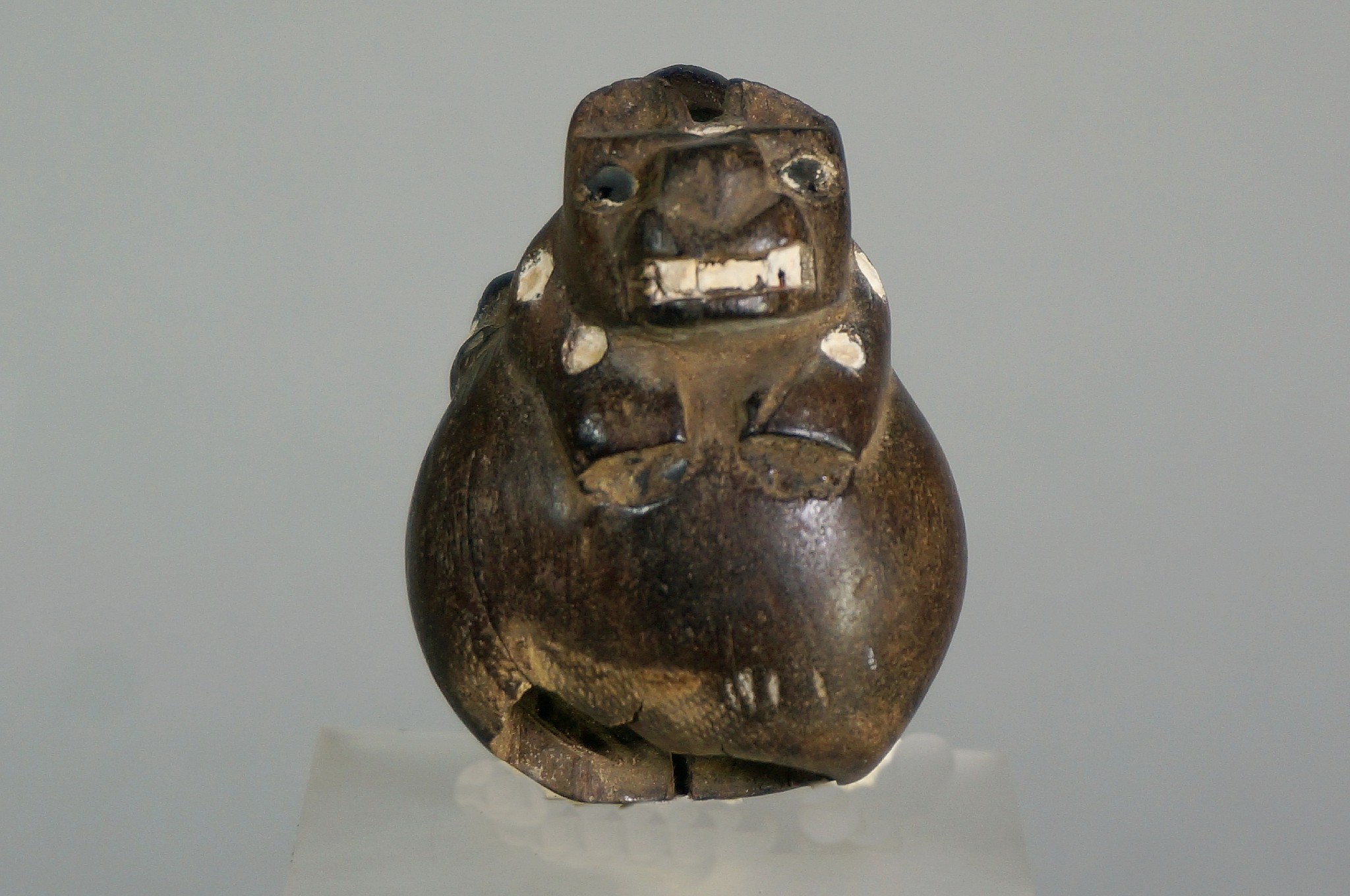





Peru, Wari Wood Lime Container with a Feline on Top with Original Shell Inlays
A small wood lime container with its original top. A recumbent feline is carved on top in high relief,
with traces of its shell teeth and spots. The bottom has been disfigured.
Period: Peru, Wari, South Coast, c. AD 600 - 900
Media: Wood
Dimensions: Height: 2"
$1,250
94265a
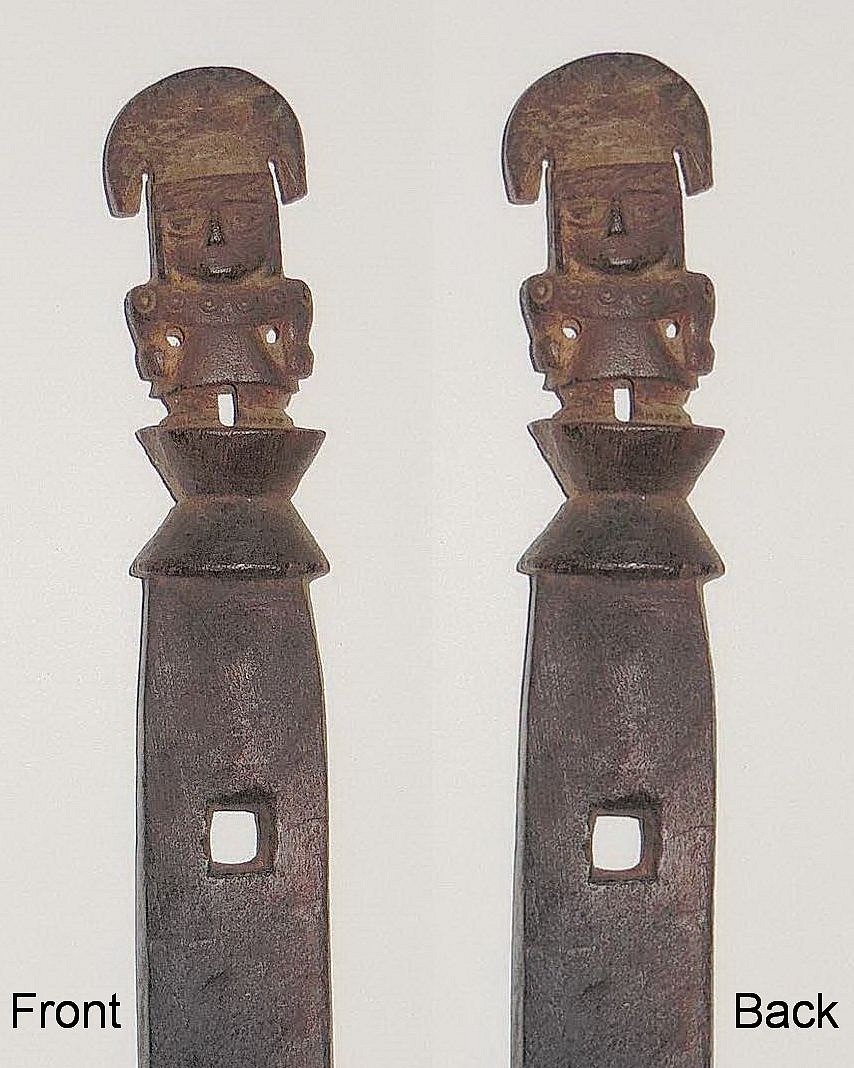









Peru, Pari of Huacho Carved Baby Carrier Posts with Reversible Figures
These beautiful wood baby carrier posts are elaborately carved with figures at the top. Each figure is reversible and appears fully carved form either side. Texas collection, prior to 1990.
Period: Peru, Huacho Valley, Late Intermediate Period, c. AD 700 - 1100
Media: Wood
Dimensions: Length: 31"
$2,400
p2030H
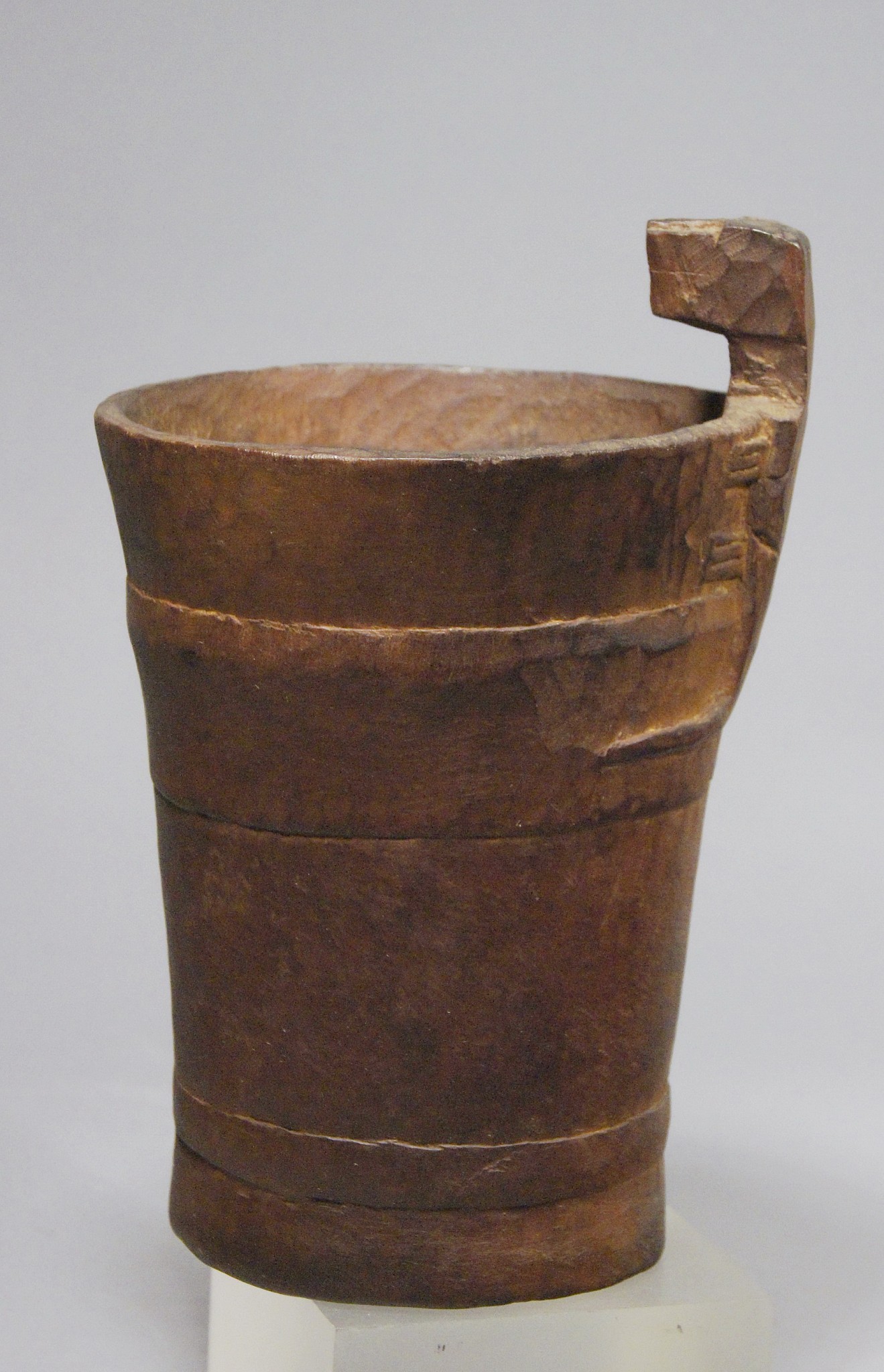




Chile, Arica Wood Kero with Lizard
This is a classic Arica cup, smoothly finished on the outside and roughly carved on the inside. A similar one has been exhibited and illustrated in the book "Arica, Diez mil Anos" (Museo Chileno de Arte Precolombino, 1991: fig. 050). Ricardo E. Latcham illustrates a cup of this type in "Arqueologia de la Region Atacamena: (1938: fig. 51). John Rowe describes these cups as the precursors to the classic Cuzco-style cups in his essay, The Chronology of Inca Wooden Cups in "Essays in Pre-Columbian Art and Archaeology" (1961: 317-341). The first example style kero was found by Gilliss and illustrated in the "U.S. Naval Astronomical Expedition to the Southern Hemisphere." (1856: III: pl. X).
Period: Chile, Arica, San Miguel, Phase North Coast, circa AD1100-1200
Media: Wood
Dimensions: Height 5 1/2" x Width 4 1/2"
$2,300
97133B
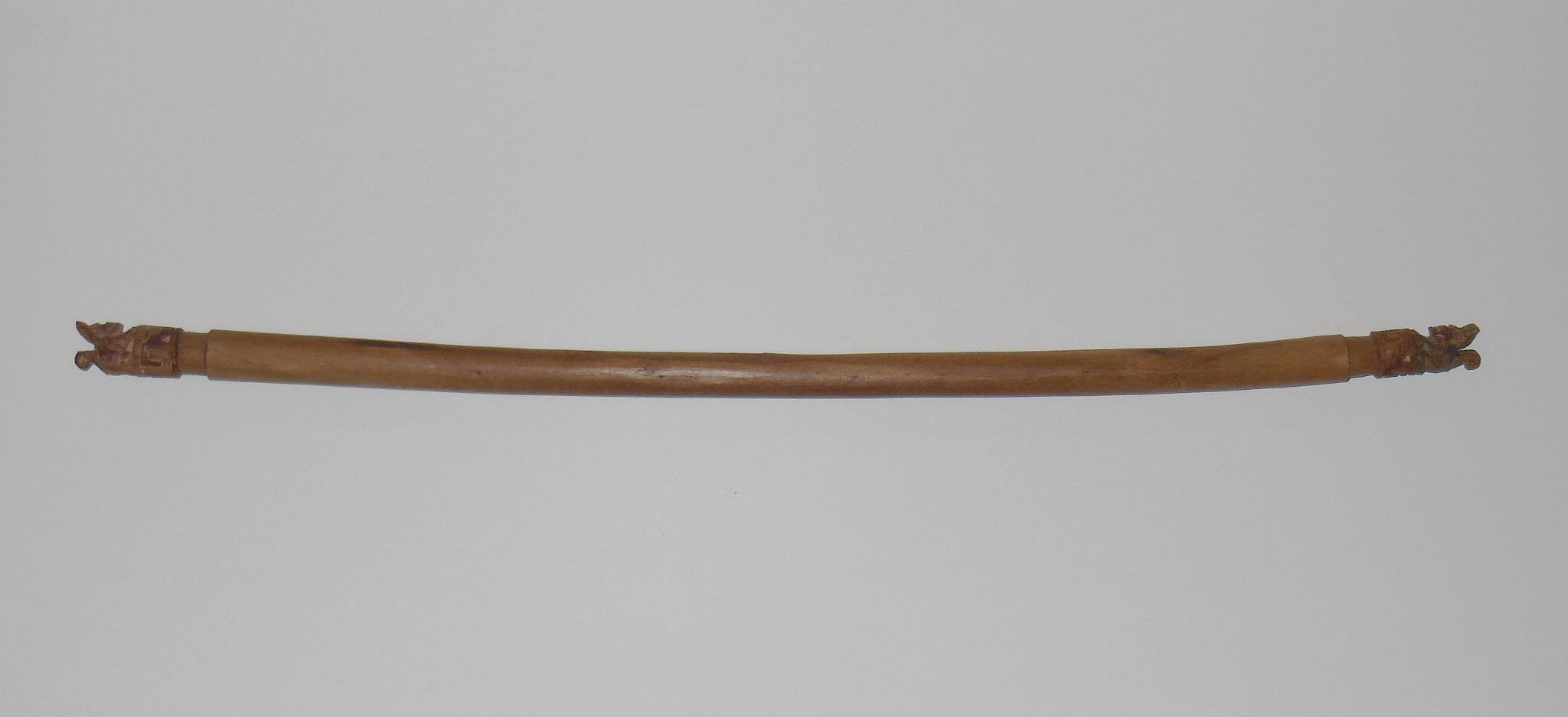




Peru, Huacho Carved Loom Bar with “Mooneater” Deities
This loom bar was once part of a backstrap loom - the most common loom type in the ancient Andes, dating back to the late Chavin Period. Andean backstrap looms are usually 22-28†in width. It would have been one of two bars needed to hold the warps together to the upper bar. This bar is elaborately decorated with an intricately carved “Mooneater†deity at each end.
Period: Peru, Huacho Valley, Late Intermediate Period, c. AD 700 - 1100
Media: Wood
Dimensions: Width: 24" x Diameter: 1/2"
$1,700
p2032H
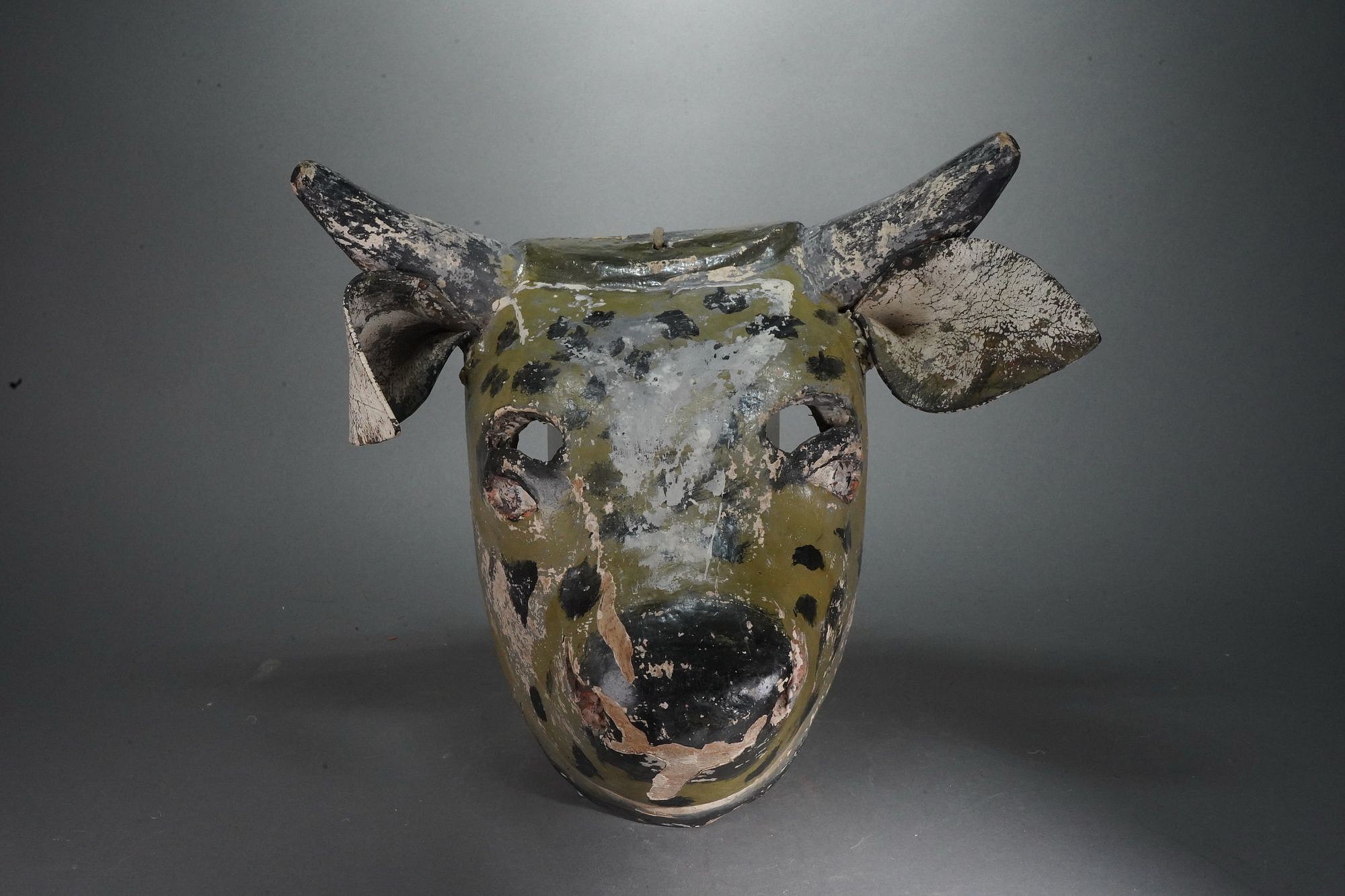




Guatemala, 19th Century Guatemalan Wood Dance Mask of a Bull
Green with black highlights Stone cut with signs of use. Formerly in the collection of Donald Cordry, San Francisco.
Period: Guatemala, Mayan, 19th Century
Media: Wood
Dimensions: Heigh: 6 1/2" : x Width: 5 3/4"
$2,000
91124
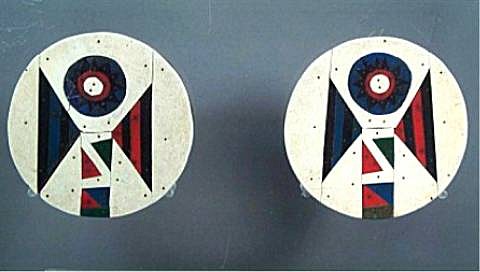
South Africa, Zulu Wood Earplugs with Red, Blue and White Vinyl Asbestos Mosaic Overlays
The custom of ear piercing was an important ceremony performed on every Zulu child before reaching puberty. As the pierce hole healed, larger and larger pieces were put into the hole until it was big enough for pieces of reed to be used. By the 1950s the advent of vinyl asbestos flooring materials inspired a fashion for much larger and more elaborately designed wood plugs. The vinyl was cut into geometrically designed patterns for overlaying the wood. These particular earplugs are distinguished with the patterns and colors attributed to the Msinga district of KwaZulu, near Johannesburg. Wearing ear plugs signified that an individual was of Zulu origins. Very similar examples are illustrated and discussed in "Africa: The Art of a Continent", Prestel, New York, 1999, p.219.
Period: South Africa, Zulu, c. Early 20th Century
Media: Wood
Dimensions: Diameter: 2 5/8"
$2,000
98038B
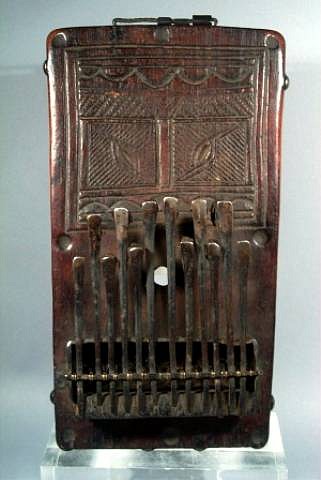
Zaire, Tchokwe "Lamellophone"with Metal Keys
Sanza is one of the many names used in Zaire, Africa, used to identify a type of instrument composed of a flat strip of wood, cane, or metal that vibrates when the attached metal keys are depressed and then released. The frame of this example is finely incised with geometric motifs. A simple motif is repeated on the reverse, perhaps the signature mark of the carver. This lamelophone is from the Tchokwe culture of the Bantu area of the central forest and southern savannah. The Bantu language has a duotonic quality, a characteristic that is exemplified in their music by a subtle polyphony and pitch. A very similar example is illustrated in Polfliet, Leo, "Bodies of Resonance: Musical Instruments of Zaire," Munich, 1985, p40.
Period: Congo, Bantu, Central Savannah, Early 20th Century
Media: Wood
Dimensions: Height: 10 1/2" x Width: 5 3/4"; Keys range from 4 3/4" to 5" in length
$2,800
92175

